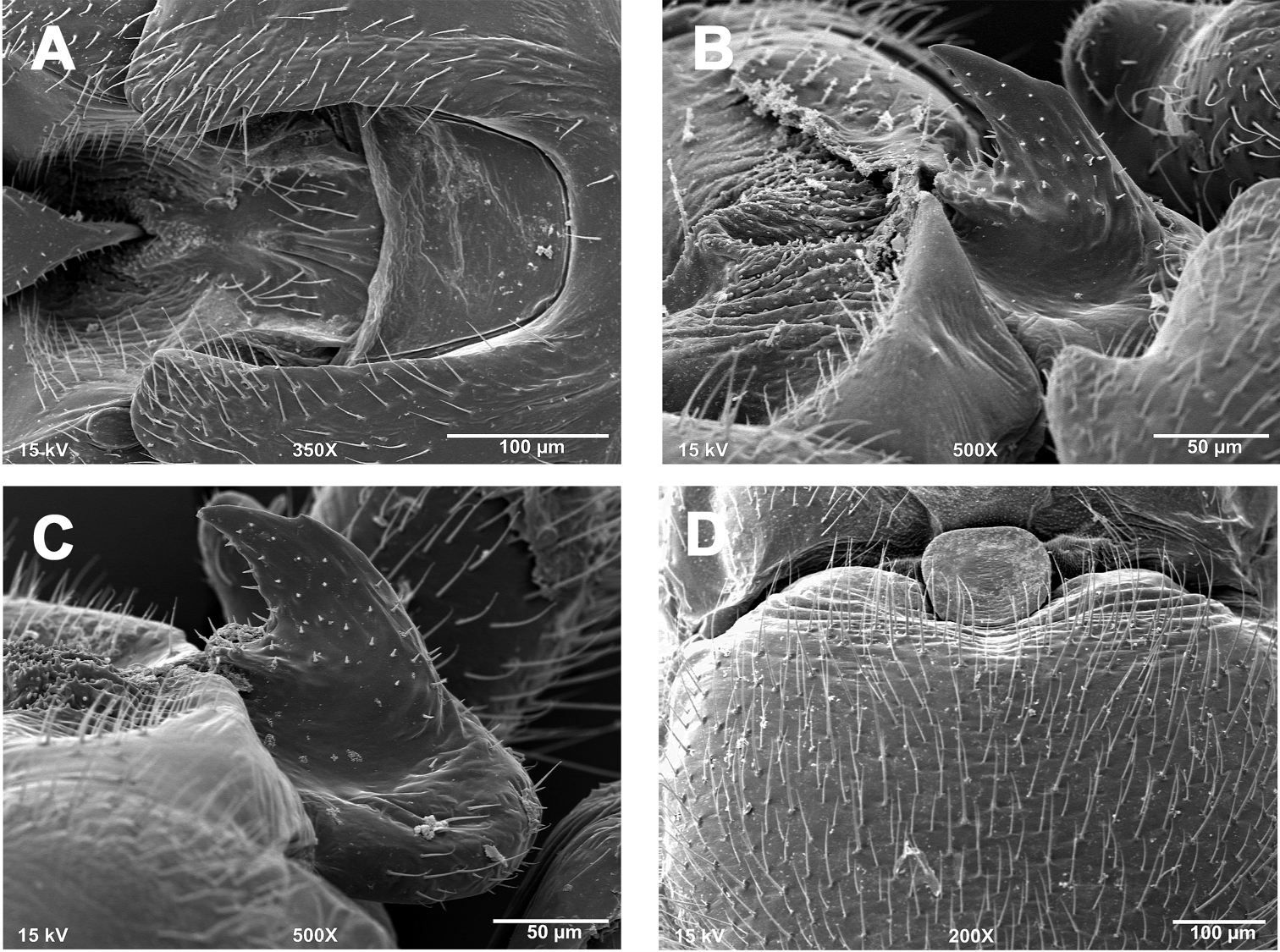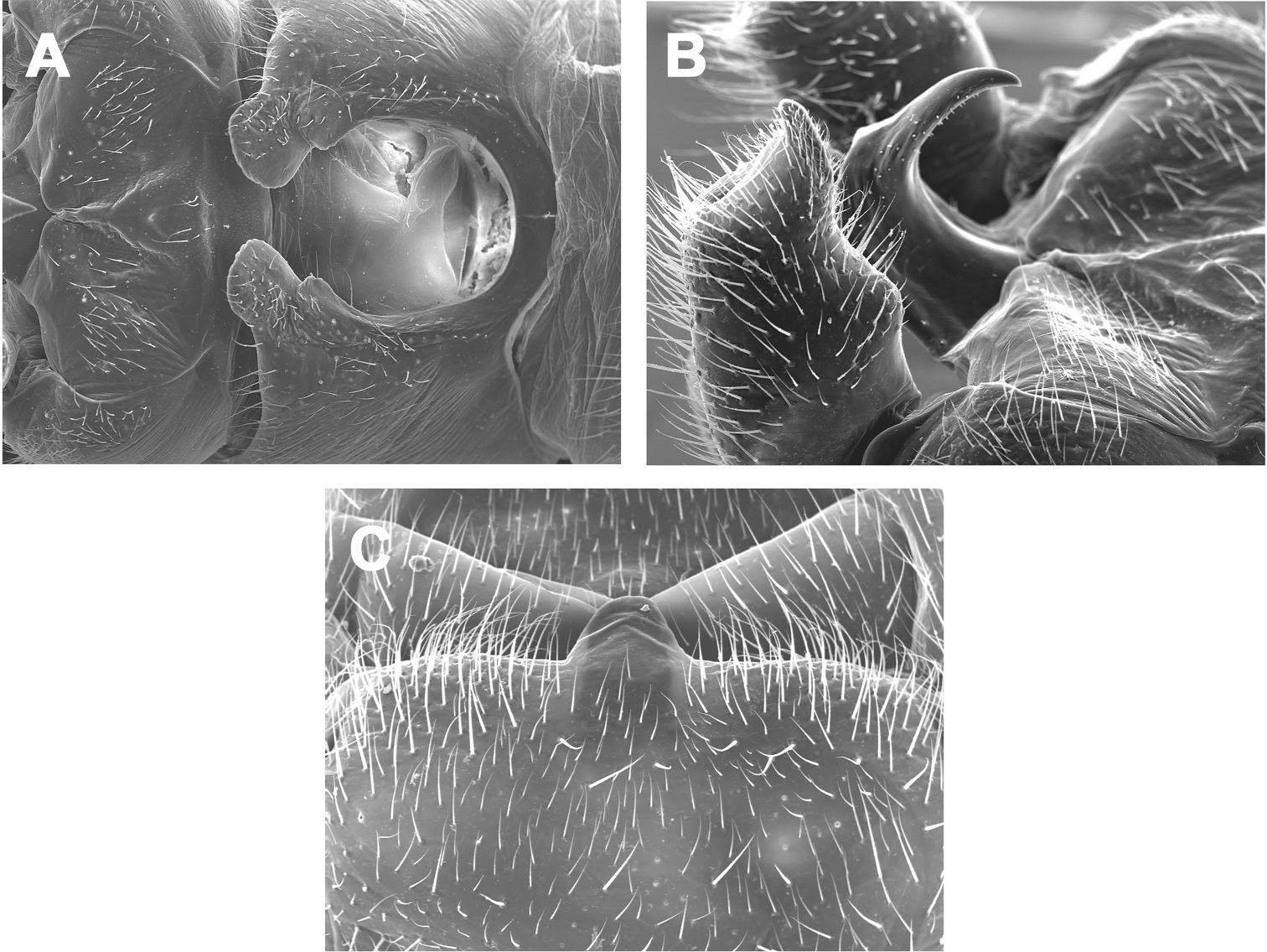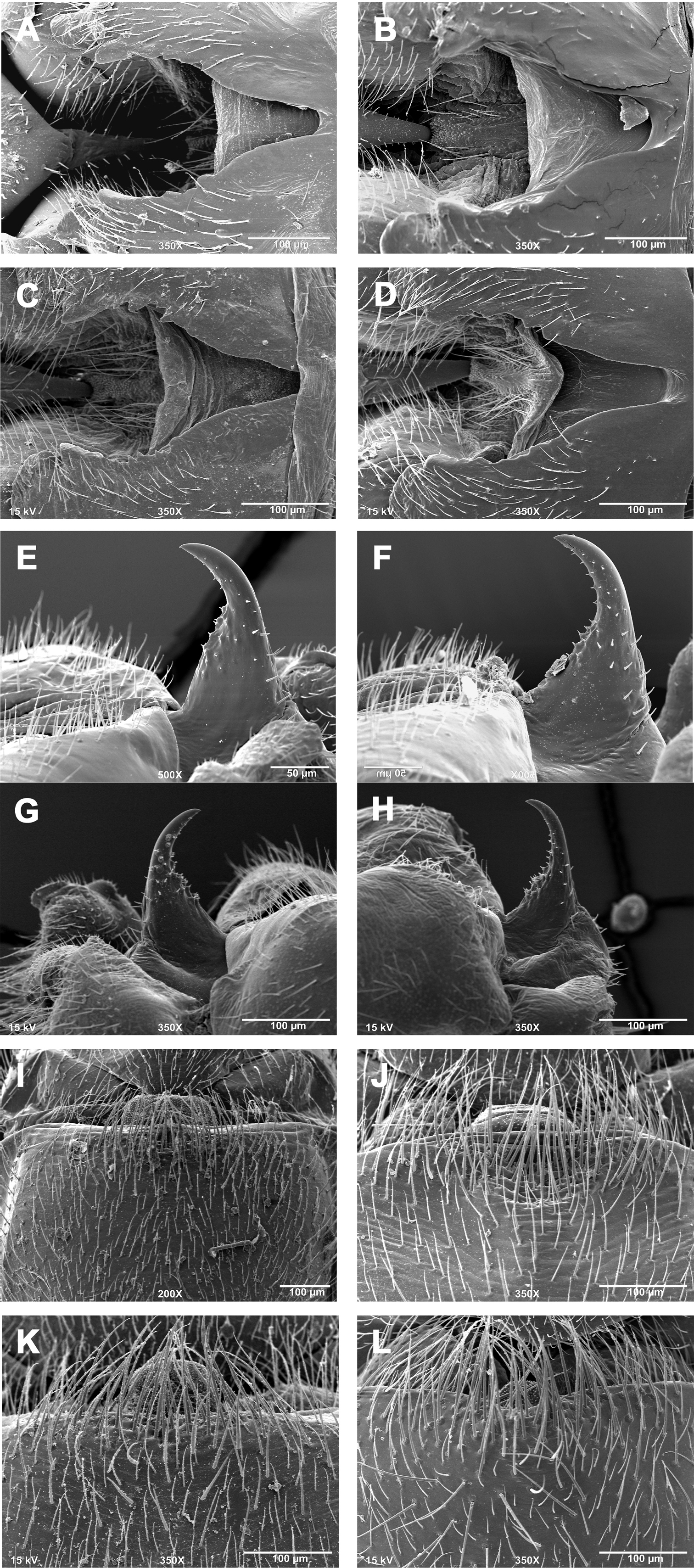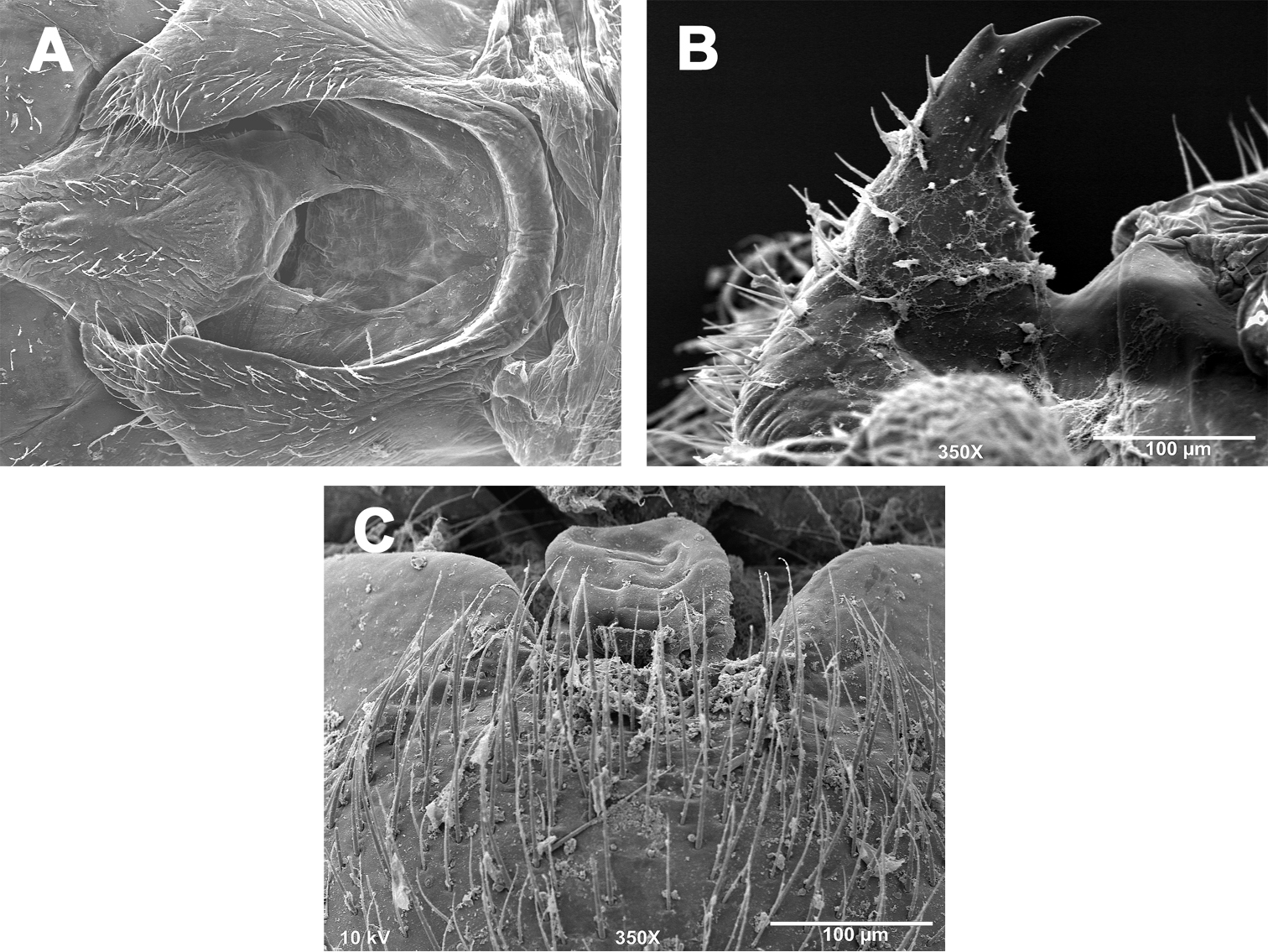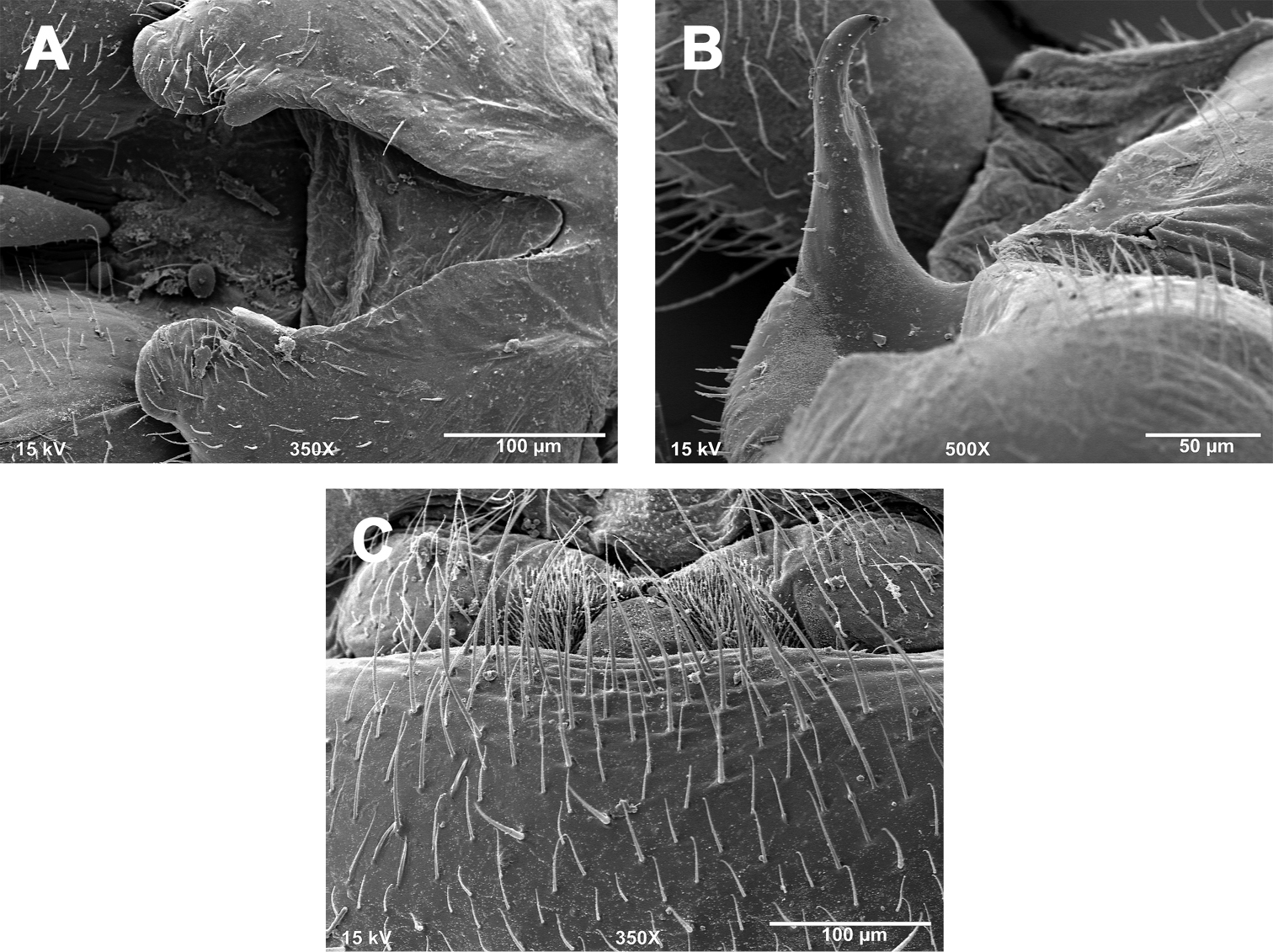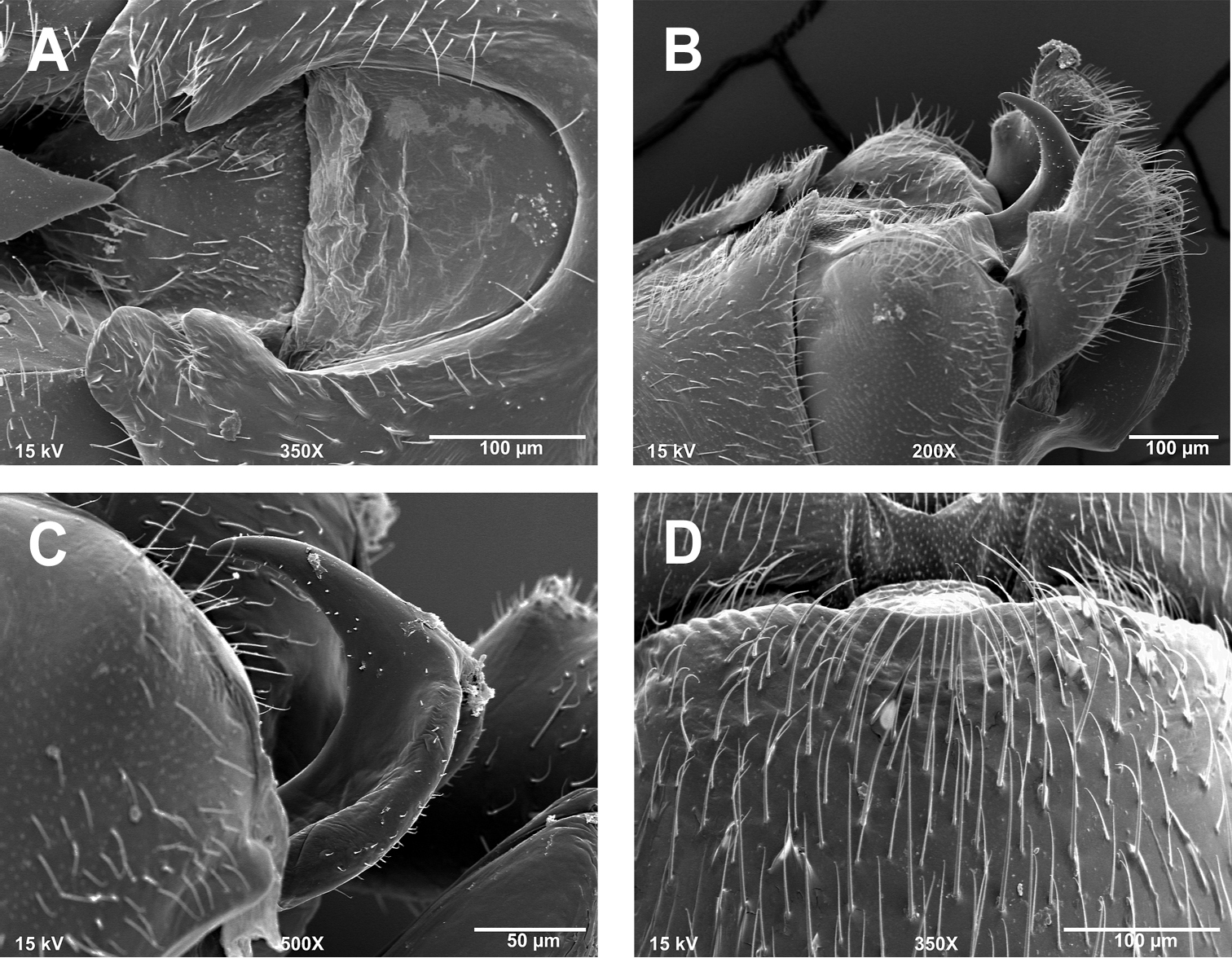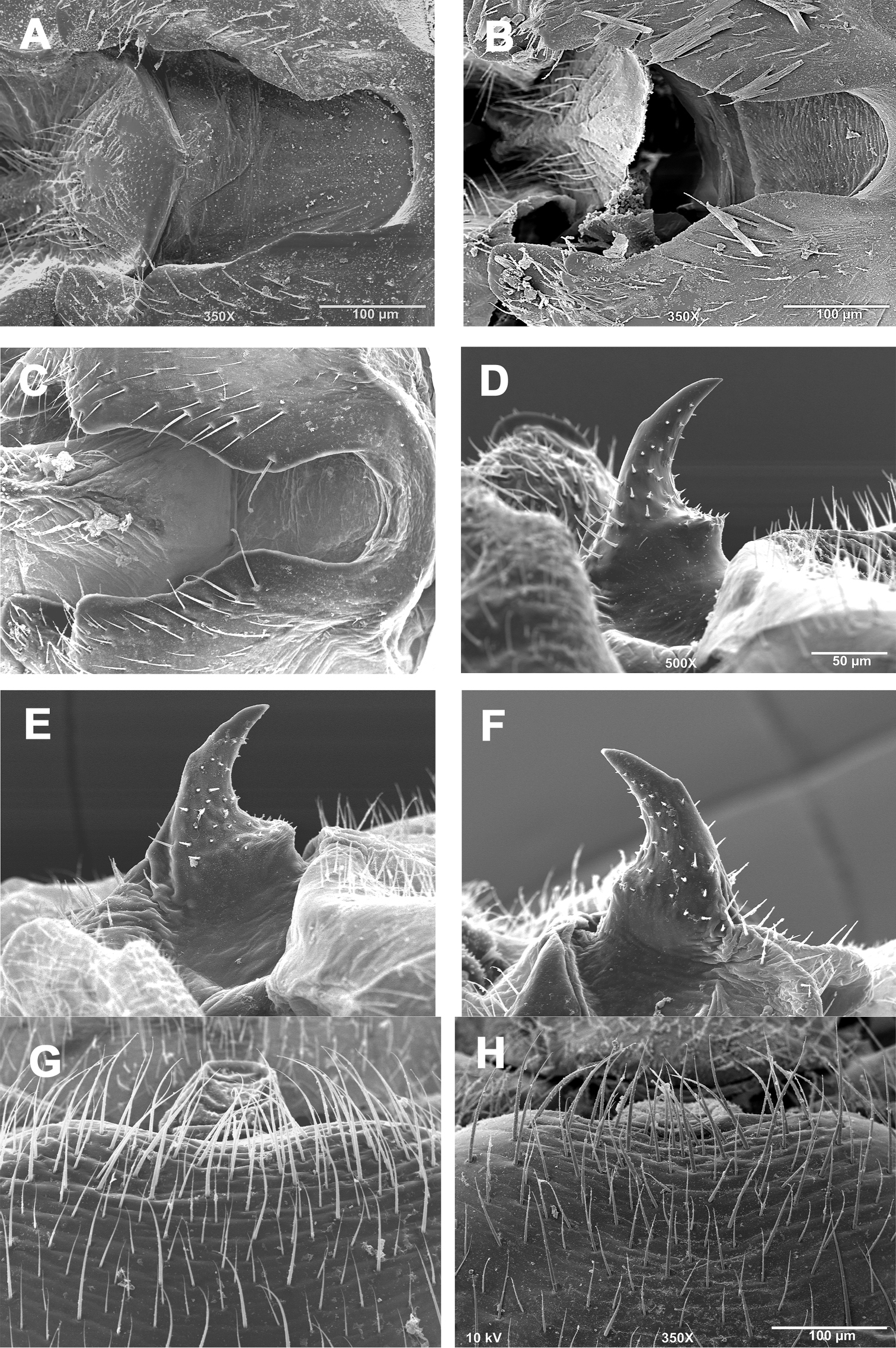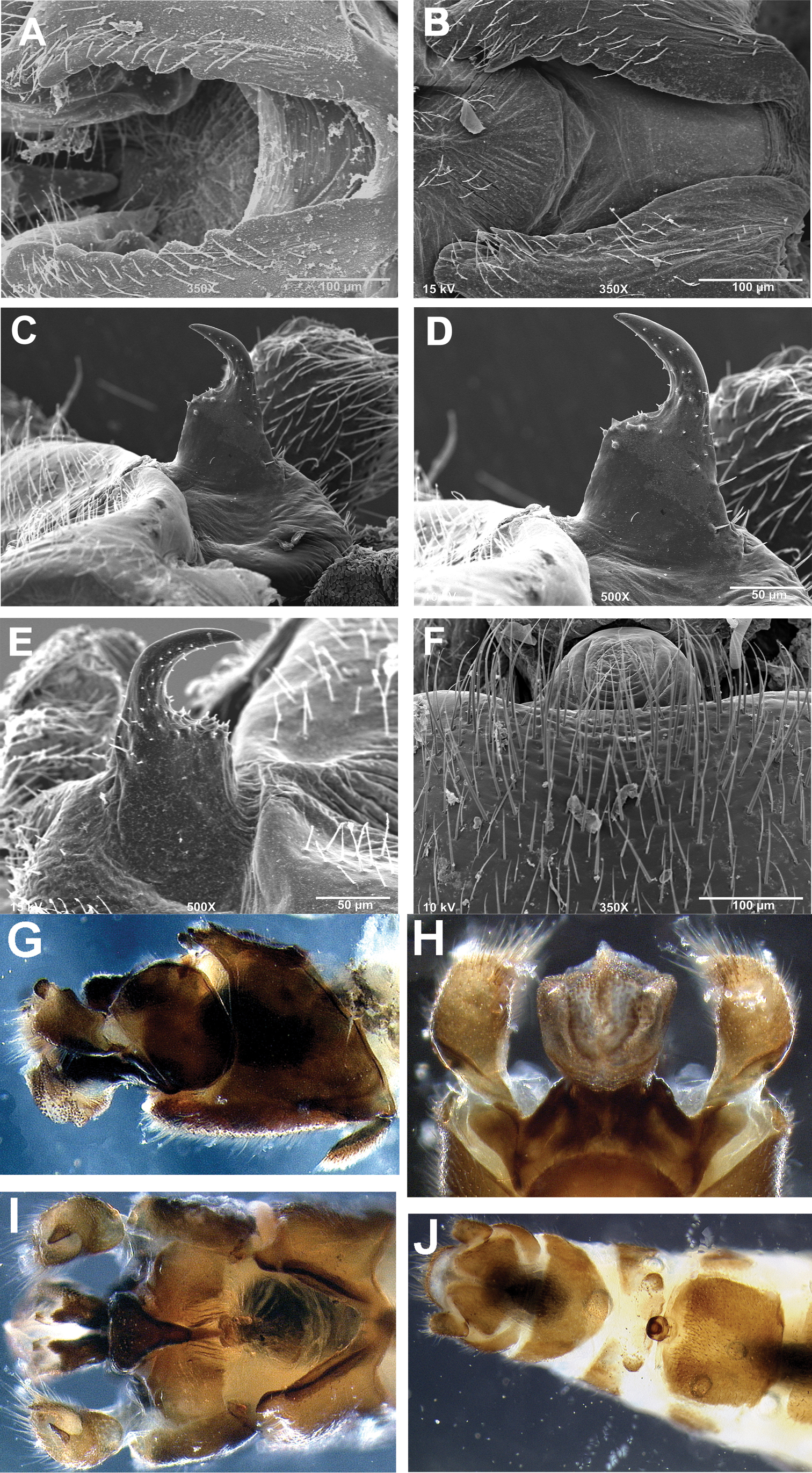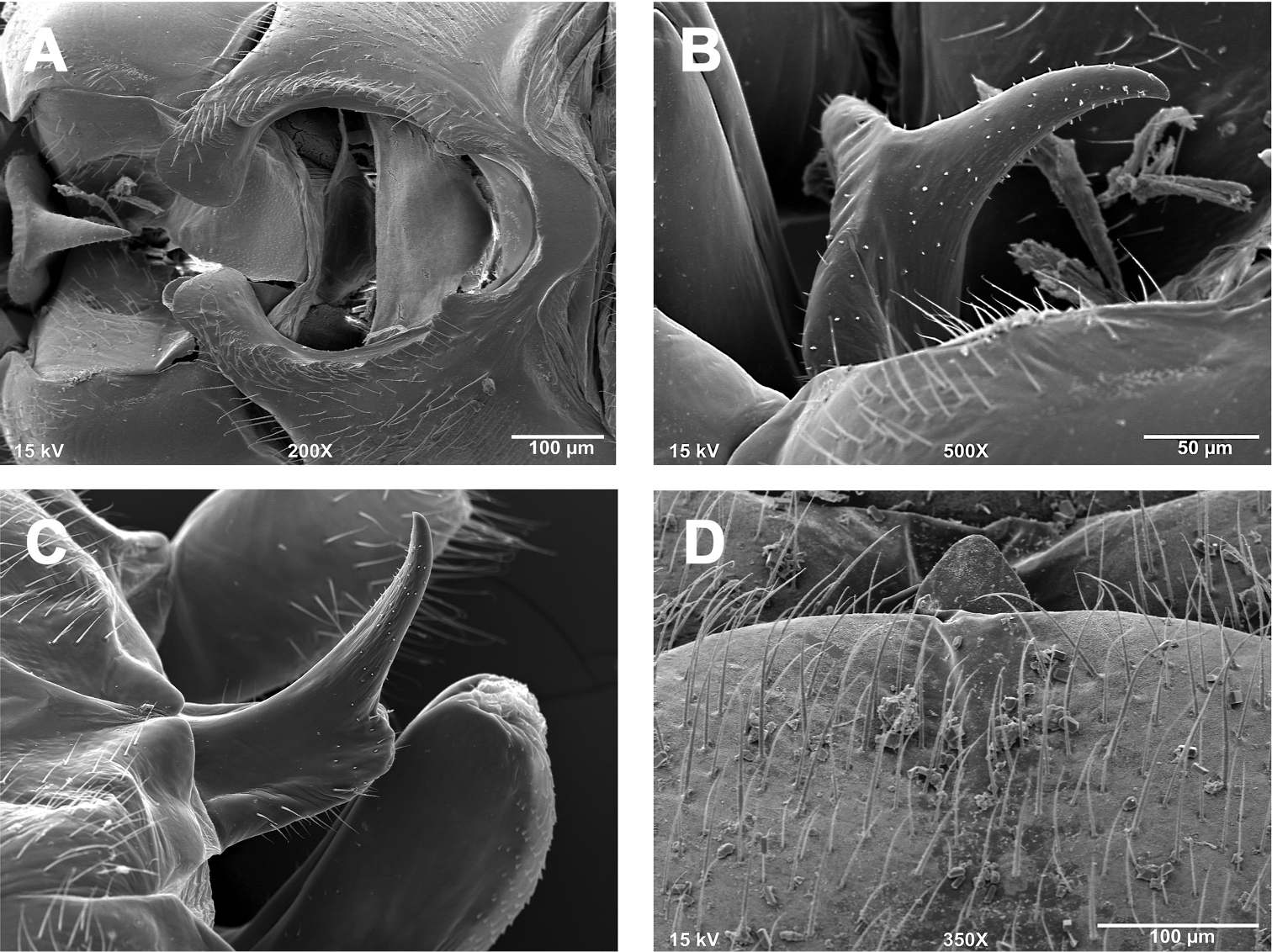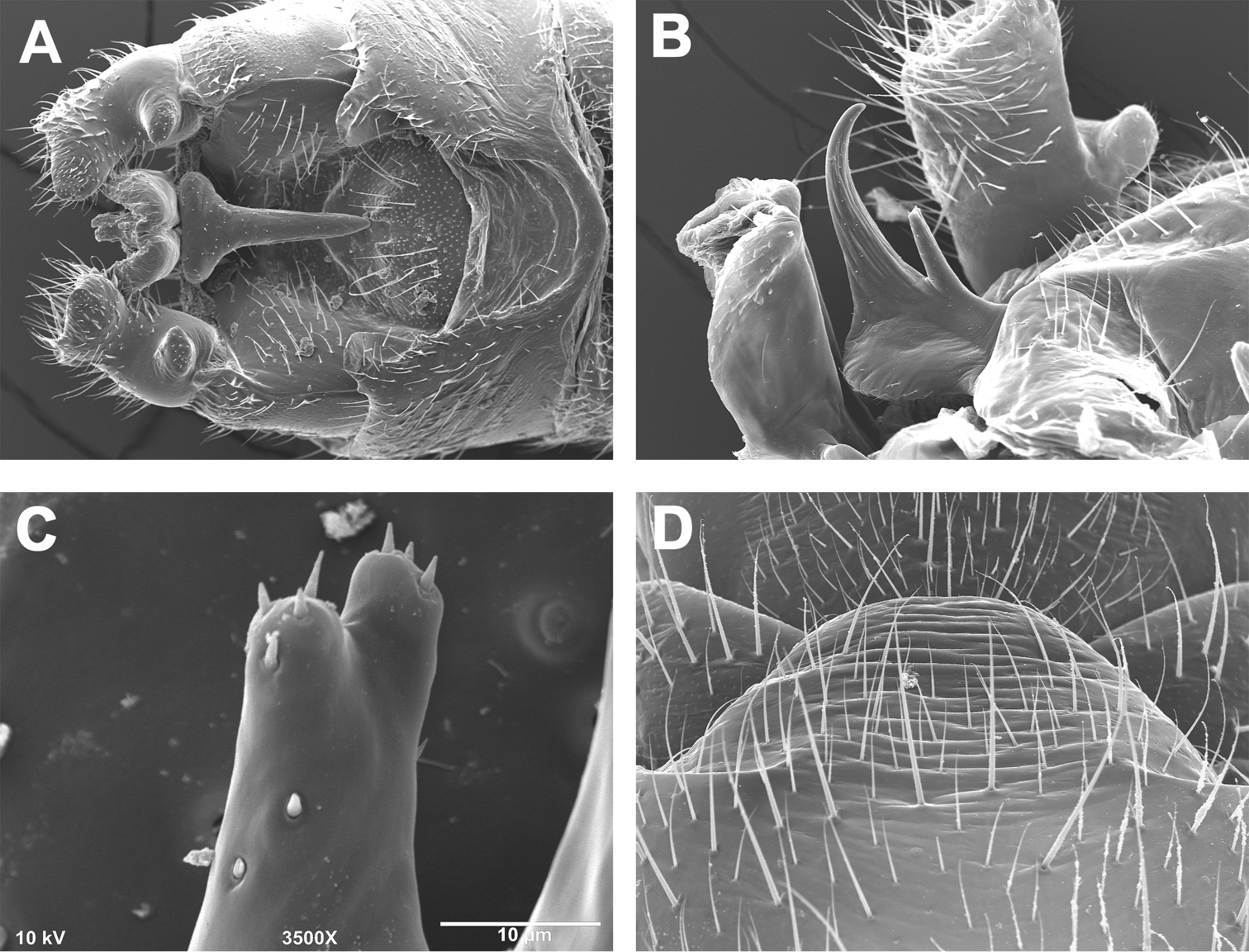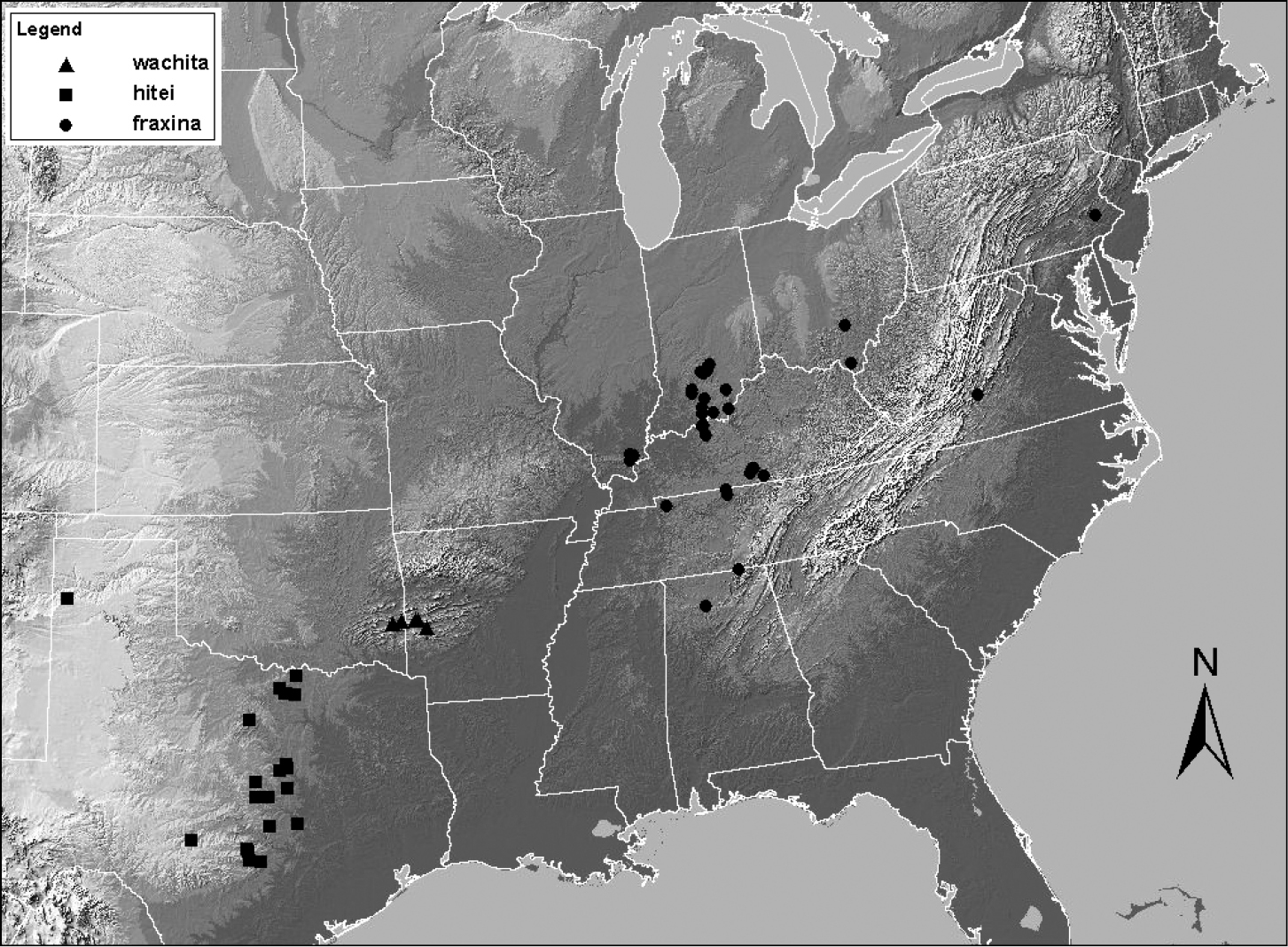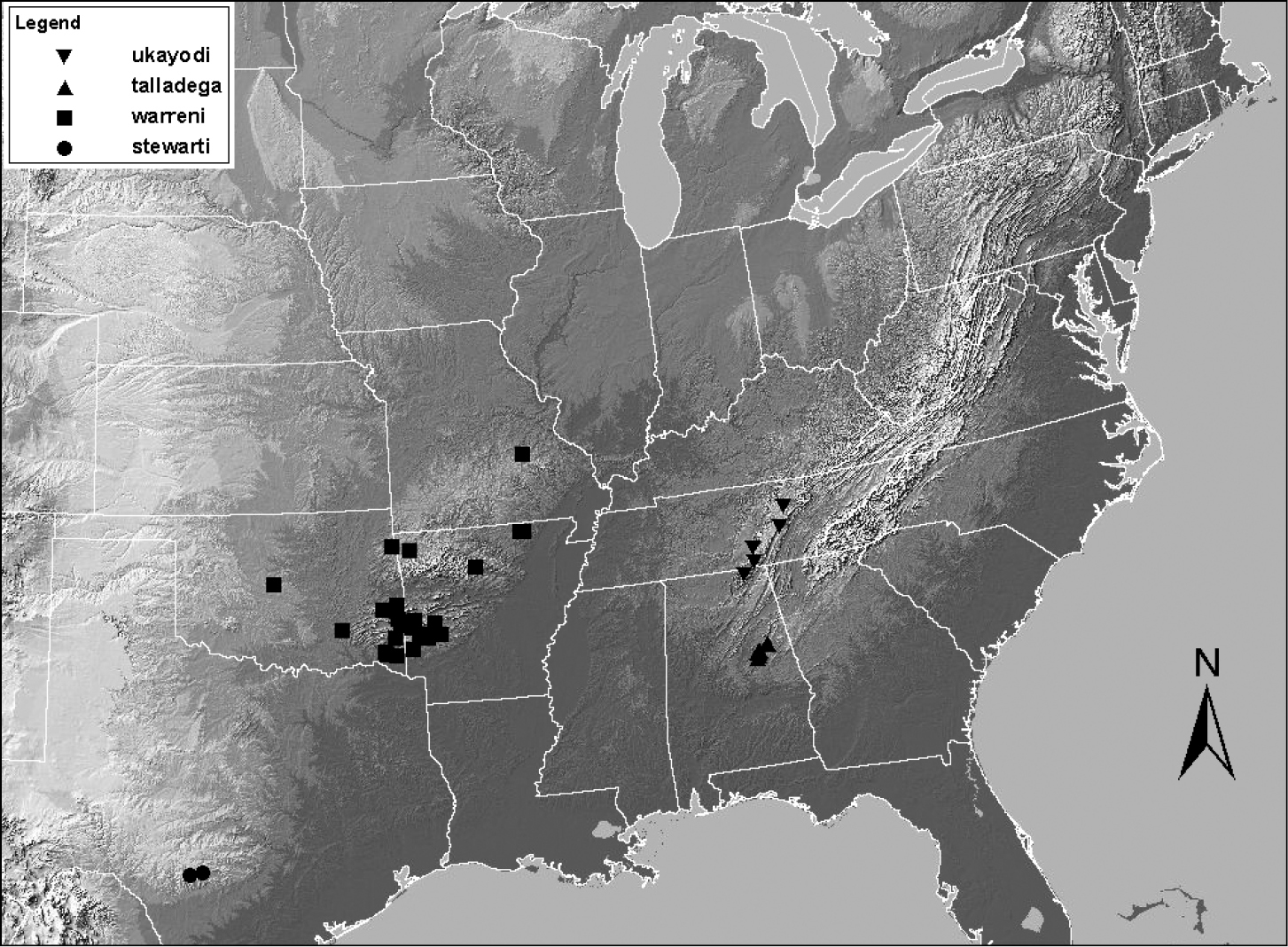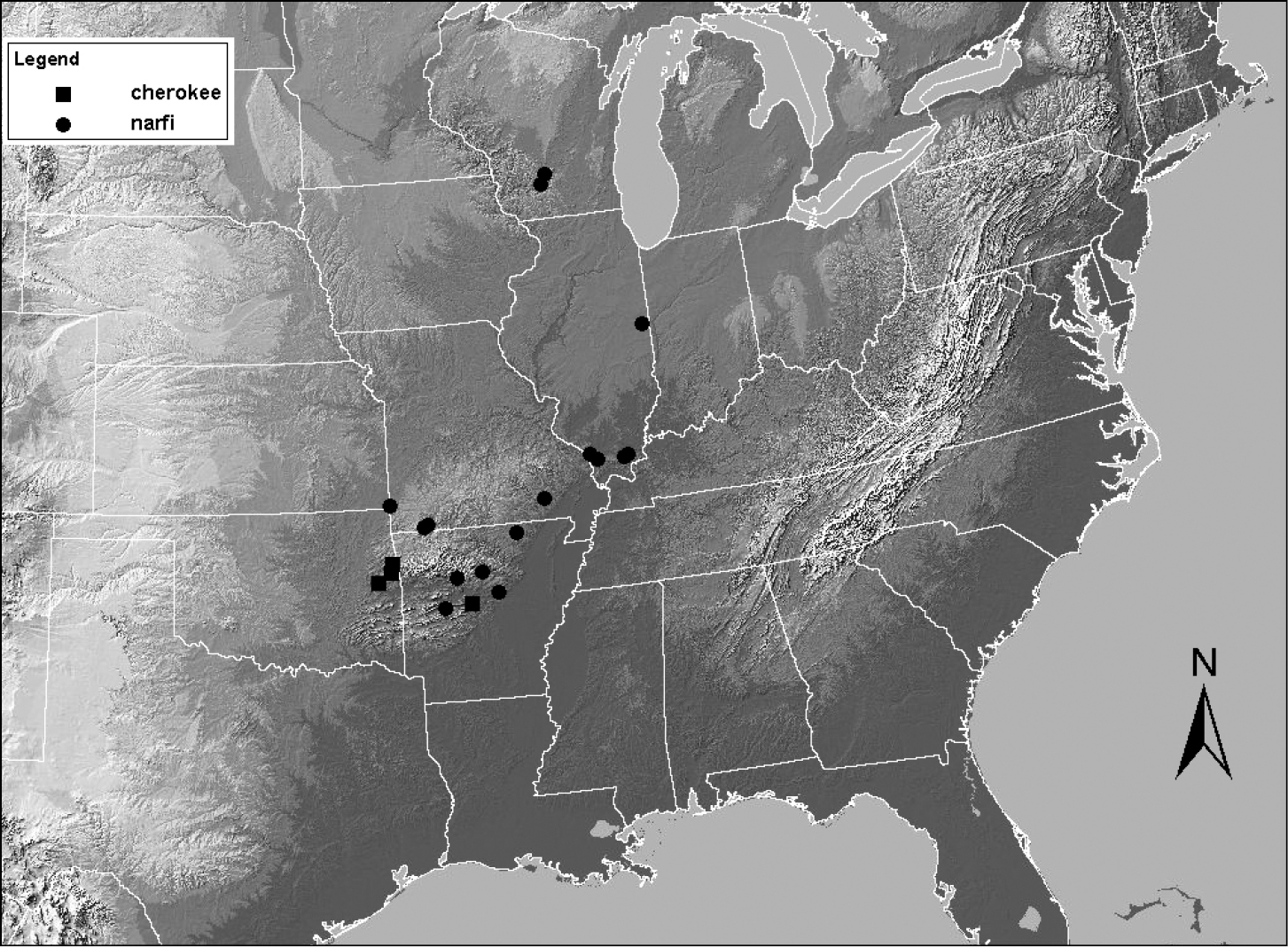






(C) 2013 Scott A. Grubbs. This is an open access article distributed under the terms of the Creative Commons Attribution License 3.0 (CC-BY), which permits unrestricted use, distribution, and reproduction in any medium, provided the original author and source are credited.
For reference, use of the paginated PDF or printed version of this article is recommended.
Citation: Grubbs SA, Kondratieff BC, Stark BP, DeWalt RE (2013) A review of the Nearctic genus Zealeuctra Ricker (Plecoptera, Leuctridae), with the description of a new species from the Cumberland Plateau region of eastern North America. ZooKeys 344: 17–47. doi: 10.3897/zookeys.344.5912
The stonefly genus Zealeuctra (Plecoptera: Leuctridae) is endemic to the central and eastern Nearctic regions and is presently comprised of 10 species. Scanning electron microscopy (SEM) was used to examine and redescribe two important diagnostic features typically used to identify and define the adult male stage: the large, anteriorly-recurved epiproct and the medial cleft of the ninth abdominal tergite. SEM was also employed to depict the posteromedial portion of female 7th sternum. A new species, Z. ukayodi sp. n., is described from the Cumberland Plateau region of northeastern Alabama and Tennessee. The new species appears superficially similar to Z. talladega Grubbs, but is easily differentiated by characteristics of the male medial cleft. An updated taxonomic key to the males of Zealeuctra is provided.
Plecoptera, Leuctridae, Zealeuctra, new species, North America
The subgenus Zealeuctra Ricker, 1952 was erected to include Leuctra claasseni Frison (
Zealeuctra is endemic to the central and eastern Nearctic regions, and is typically associated with intermittent or temporary upland streams (
Zealeuctra exhibits several unique characteristics in the adult stage, namely the swollen male cerci with accessory humps and/or spines, the male ninth tergite bearing a conspicuous medial depression (i.e. “cleft”), and the female seventh sternite having a posteromedial lobe (although secondarily lost in two species;
In this study scanning electron microscopy (SEM) was employed to examine two diagnostic features of Zealeuctra males, focusing on the epiproct and the abdominal cleft. The posteromedial portion of the female seventh abdominal segment is also depicted with SEM micrographs. A new species is described herein and an updated taxonomic key to the males of Zealeuctra is provided.
Most of the Zealeuctra specimens examined in this study were obtained from the Monte L. Bean Museum, Brigham Young University, Provo, Utah, USA (BYUC), C.P. Gillette Museum, Colorado State University, Fort Collins, Colorado, USA (CSUC), S.A. Grubbs collection, Western Kentucky University, Bowling Green, Kentucky, USA (WKUC), B.P. Stark Collection, Mississippi College, Clinton, Mississippi, USA (BPSC), and the Illinois Natural History Survey, Champaign-Urbana, Illinois, USA (INHS). Other codens used were TAMU (Texas A&M University Insect Collection, College Station, Texas, USA), and USNM (National Museum of Natural History, Smithsonian Institute, Washington D.C., USA). Location data (in decimal degrees) for each specimen record were recorded either directly with portable GPS units or georeferenced from vial label data (if possible).
Specimens for SEM analyses were dehydrated through a series of 75%, 90%, 95%, and 100% ethanol for 10 minutes each, and placed in Hexamethyldisilizane for 30 minutes. Dehydrated specimens were attached to aluminum stubs with double-stick tape and coated with gold-palladium using an Emscope SC500. Coated specimens were examined using a Jeol JSM-5400LV scanning electron microscope and digital images were captured with an IXRF system.
Testing
An updated taxonomic key to the males of Zealeuctra is provided, and a new Zealeuctra species is described herein from the Cumberland Plateau region of southern Tennessee and northeastern Alabama.
| 1 | Cleft (=medial depression) tapering and V-shaped, especially in anterior half (Figs 3A–D, 5A) | 2 |
| – | Cleft distinctly U-shaped in anterior half (Figs 1A, 4A, 9A) | 3 |
| 2 | Epiproct with a broad triangular base (Figs 3E–H); inner margins of cleft bearing several medial crenulations (Figs 3A–D); widespread distribution across the eastern and central USA (Fig. 12) | Zealeuctra claasseni (Frison) |
| – | Epiproct base narrowly triangular and with a minor shelf-like anterior projection (Figure 5B); inner margins of cleft lacking crenulations and with only a single tooth-like medial projection in posterior half (Fig. 5A); known mainly from central Texas (Fig. 11) | Zealeuctra hitei Ricker & Ross |
| 3 | Distal portion of epiproct with only one spine (Figs 2B, 8D, 9C) | 4 |
| – | Distal portion of epiproct comprised of two distinct spines (Fig. 4B) or one prominent spine plus a prominent, accessory posterior cusp (Figs 1C, 10B) | 9 |
| 4 | Epiproct spine very long and slender ( |
Zealeuctra stewarti Kondratieff & Zuellig |
| – | Epiproct spine markedly shorter, either lacking (Figs 2B, 6C, 9C) or bearing a prominent anterior shelf-like projection at base (Fig. 7E–F, 8C–E) | 5 |
| 5 | Epiproct bearing a prominent shelf-like projection at base, either rounded and subquadrate (Figs 6F, 8C–8D) or angular and squarish (Figs 7D–D, 8E) | 6 |
| – | Epiproct base not as above (Figs 2B, 6C, 9C) | 7 |
| 6 | Inner margins of cleft sinuous, without crenulations along inner margins (Figs 7A–7C); anterior, recurved portion of epiproct possessing a minute, medially-positioned hump (Figs 7D–F); known only from the southern Talladega Mountains region of eastern Alabama (Fig. 13) | Zealeuctra talladega Grubbs |
| – | Inner margins of cleft V-shaped to almost sinuous, bearing several large crenulations along inner margins on posterior half (Figs 8A–B); anterior, recurved portion of epiproct possessing a medial hump (Figs 8C–E); distributed across the southern Cumberland Plateau region from central Tennessee south to northeastern Alabama (Fig. 13) | Zealeuctra ukayodi Grubbs, sp. n. |
| 7 | Anterior portion of cleft with a secondary U-shaped extension, with inner margins set apart from remainder of cleft, medial subtruncate thumb-like projections present at terminus of cleft (Fig. 9A); epiproct anteriorly recurved gradually from base to tip (Fig. 9C) | Zealeuctra wachita Ricker & Ross |
| – | Cleft U-shaped, with margins concave and contiguous throughout entire length, two medially-projected terminal processes present at terminus of cleft (Figs 2A, 6A); epiproct recurved abruptly, ca. 90° degree angle anteriorly (Figs 2B, 6C) | 8 |
| 8 | Epiproct with a small, thickened, shelf-like structure posteriorly (Fig. 2B) | Zealeuctra cherokee Stark & Stewart |
| – | Epiproct lacking a posterior thickening (Fig. 6C) | Zealeuctra narfi Ricker & Ross |
| 9 | Epiproct comprised of two prominent spines, a large posterior spine plus an accessory anterior spine (Fig. 10B) | Zealeuctra warreni Ricker & Ross |
| – | Epiproct bearing only a small, subterminal cusp posterior to the main spine (Figs 1B, 4C) | 10 |
| 10 | Epiproct base bearing a conspicuous, slightly concave cusp anteriorly (Figs 1B–C); known only from Texas (Fig. 12) | Zealeuctra arnoldi Ricker & Ross |
| – | Epiproct base simple and lacking a prominent cusp, at most, only a very small rounded projection anteriorly (Fig. 4C); sporadically distributed across the central and eastern USA (Fig. 11) | Zealeuctra fraxina Ricker & Ross |
http://species-id.net/wiki/Zealeuctra_arnoldi
Figs 1, 12Male - epiproct. Base short and robust, narrowing slightly to a short, recurved, subtriangular spine (Figs 1B–C). A short, slightly concave projection extends anteriorly from the base to approximately the same plane as the spine. Base with bulbous posterior swelling, spine with small accessory posterior cusp that is low and nub-like.
Female - 7th sternum. Seventh sternum with a large, subquadrate lobe nested in a distinct, central notch. The notch is bordered laterally by large, convex “shoulders” (Fig. 1D).
Male - abdominal tergal cleft. Simple in outline. Anterior portion wide and broadly U-shaped, with a nearly straight terminal margin (Fig. 1A). Posterior portion narrowing slightly with no medial projections and only scarcely visible crenulations along inner margins.
Zealeuctra arnoldi, scanning electron micrographs, USA, Texas, Uvalde Co., Cherry Creek, 3 April 2004. A male, cleft, dorsal view, 350× B male, epiproct, lateral view, 500× C male, epiproct, lateral view, 500× D female, posteromedial portion of seventh abdominal sternite, 200×.
USA, Texas: Bandera Co., Myrtle Creek, FR 2828 S of Camp Verde, 29.8242, -99.1347, 3.IV.2004, B.C. Kondratieff and R.E. Zuellig, 4♂, 13♀ (CSUC); Little Creek, Farm Rd. 470 E of Utopia, 29.6514, -99.4767, 3.IV.2004, B.C. Kondratieff and R.E. Zuellig, ♂ (CSUC); Hays Co., Barton Creek, Hwy 12, N of Dripping Springs, 30.2380, -98.0665, 14.III.1993, B.C. Kondratieff and R.W. Baumann, 5♂, 21♀ (BYUC, CSUC); Paradise Hills, 25 January 1988, B.P. Stark, 2♂, 2♀ (BPSC); Travis Co., tributary of Barton Creek, near bowery of Hill Country Preserve in Bee Caves, downstream of Hwy 71, 20.III.1997, C.R. Nelson, 18♂, 13♀ (BYUC); Uvalde Co., Cherry Creek, Farm Rd. 1050 W of Utopia, 29.6061, -99.6925, 3.IV.2004, B.C. Kondratieff and R.E. Zuellig, 54♂, 38♀ (CSUC); Bear Creek, Farm Rd, 1050 W of Utopia, 29.5989, -99.5664, 3.IV.2004, B.C. Kondratieff and R.E. Zuellig, 72♂, 68♀ (CSUC).
USA: TX (
This species is somewhat superficially similar to Zealeuctra fraxina. Males are easily identified by the combination of the simple, U-shaped cleft and the presence of the anterior, concave cusp present at the base of the short, compact epiproct spine. The depiction of the posterior cusp as pointed and acute in
http://species-id.net/wiki/Zealeuctra_cherokee
Figs 2, 14Male - abdominal tergal cleft. Anterior portion U-shaped and very broadly rounded, posterior portion narrowing distally to a pair of medial projections, the terminal projection larger, subtruncate, and thumb-like, the subterminal projection smaller and subtriangular (Fig. 2A). Crenulations absent from inner margins of cleft.
Male - epiproct. Broad at base, extending posteriorly along one plane then extended abruptly and dorsally at a ca. 90 degree angle (Fig. 2B), spine tip slightly recurved anteriorly. No accessory spine or cusp present.
Female - 7th sternum. Seventh sternum with a small, subtriangular lobe nested in a distinct central notch (Fig. 2C).
Zealeuctra cherokee, scanning election micrographs, USA, Oklahoma, Adair Co., 9 mi S Stillwell, Hwy 59, 20 February 1972. A male, cleft, dorsal view, 200× B male, abdominal terminalia, lateral view, 350× C female, posteromedial portion of seventh abdominal sternite, 350×.
USA, Arkansas: Perry Co., Greathouse Creek, Hwy 216, 3 mi NE Thornburg, 34.9574, -92.7545, 7.IV.1984, B.C. Poulton, ♂ (CSUC); Sebastian Co., tributary to Sugar Creek, 5 mi SW Hartford, 17.II.1985, B.C. Poulton, ♂, ♀ (BYUC). Oklahoma: Adair Co., 9 mi S Stillwell, Hwy 59, 35.6917, -94.6691, 20.II.1972, B.P. Stark, 4♂, 5♀ (Paratypes, BPSC).
USA: AR, OK (
The cleft and epiproct spine of the male of this species are very similar to that of Zealeuctra narfi. The major difference for Zealeuctra cherokee is the presence of the posterior thickening along the recurved portion of the epiproct spine, and additionally, the subtruncate terminal medial processes at the posterior end of the cleft. The ranges of these two species broadly overlap in Arkansas and eastern Oklahoma (Fig. 14;
http://species-id.net/wiki/Zealeuctra_claasseni
Figs 3, 12Male - abdominal tergal cleft. Anterior portion V-shaped with slight inward medial swelling but lacking crenulations along inner margins, anterior terminus very narrowly rounded (Figs 3A–D). Posterior portion slightly more U-shaped with several irregularly-sized and rounded teeth projecting medially.
Male - epiproct. Triangular base narrowing to anteriorly-recurved and tapering terminal spine, no accessory spine or swelling present (Figs 3E–H). Conspicuous tubercles located on the anterior margins of the triangular base. No accessory spine or cusp present.
Female - 7th sternum. Seventh sternum with a small, variably-shaped lobe nested in a small central notch (Figs 3I–3L). The lobe ranges in shape from somewhat quadrate to broadly convex. The notch is likewise variably shaped, from essentially straight and scarcely perceptible (Figs 3I, 3K) to slightly concave (Figs 3J, 3L). Posterior margin essentially straight.
Zealeuctra claasseni, scanning electron micrographs, USA, Indiana, Franklin Co., Blue Creek, 20 March 2002 (A, E, I), Kentucky, Monroe Co., Little Sulphur Creek, 18 March 2001 (B, F, J), Missouri, Hog Creek, 17 March 2002 (C, G, K) Oklahoma, West Cache Creek, 5 February 2003 (D, H, L). A–D male, cleft, dorsal view, 350× E–H male, epiproct, lateral view, 350× or 500× I–L female, posteromedial portion of seventh abdominal sternite, 200× or 350×.
USA, Arkansas: Baxter Co., High Tower Creek, Hwy 126 S of Monkey Run, 36.3369, -92.4743, 16.III.2002, B.C. Kondratieff and R.E. Zuellig, 31♂, 24♀ (CSUC); Logan Co., West Fork Hegwood Creek, Hwy 22, 3 mi E Paris, 35.2950, -93.6782, 21.III.1984, B.C. Poulton, 2♂, 3♀ (BYUC); Newton Co., Buffalo River, Hwy 21 bridge S of Boxley, 35.9610, -93.4042, 10.III.2002, B.C. Kondratieff and R.E. Zuellig, 8♂, 3♀ (CSUC). Illinois: Alexander Co., tributary to Sandy Creek, 4.8 km WNW Tamms, 37.2450, -89.3210, 25.IV.2001, D.W. Webb, ♂, ♀ (INHS); Hardin Co., Threemile Creek, 6.5 km WNW Elizabethtown, 5.IV.2000, R. E. DeWalt, ♂, ♀ (INHS); Jackson Co., tributary to Big Muddy River, Clear Springs Picnic Area, 3.5 km ESE Howardton, 37.6234, -89.4255, 7.IV.1992, M.A. Harris and M.J. Wetzel, ♂, ♀ (INHS); Pope Co., Burden Branch, Burden Falls, Shawnee National Forest, 37.5633, -88.6424, 20.IV.1992, D.W. Webb and M.A. Harris, ♂, 3♀ (INHS); Dog Creek, 9 km NW Hamletsburg at CR 1, Shawnee National Forest, 37.2041, -88.4914, 10.III.2011, R.E. DeWalt and M.R. Jeffords, 17♂, 9♀ (INHS); Gibbons Creek, 0.8 km N Herod, 37.5842, -88.4422, 5.IV.2000, R.E. DeWalt, ♂ (INHS); tributary to Lusk Creek, 0.8 km N Rising Sun, 37.4156, -88.5797, 28.III.2006, R.E. DeWalt, 3♂, 6♀ (INHS); Lusk Creek, SE of Eddyville, 37.4729, -88.5472, 28.III.2006, R.E. DeWalt, ♂, 3♀ (INHS). Indiana: Brown Co., Jackson Creek, 8 km W Nashville, Yellowwood State Forest, 39.2075, -86.3461, 7.IV.2001, S.A. Grubbs, ♂, ♀ (WKUC); Spanker Branch, 14 km S Nashville, 39.0700, -86.2623, 7.IV.2001, S.A. Grubbs, ♂, 2♀ (WKUC); Skinner Creek, 8 km SSE Nashville, Brown County State Park, 39.1395, -86.2066, 7.IV.2001, S.A. Grubbs, 7♂, 6♀ (WKUC); Clark Co., Nine Penny Branch, 4 km NE Charleston, Nine Penny Branch Nature Preserve, 38.4772, -85.6318, 13.III.2000, S.A. Grubbs and J.M. Ferguson, 4♂ (WKUC); Crawford Co., small spring-fed stream, Rich Cave Hollow, 2.5 km N Branchville, Saalman Hollow Nature Preserve, 38.1907, -86.5732, 12.III.2000, S.A. Grubbs and J.M. Ferguson, ♂, 1 nymph (WKUC); Mitchell Creek, 2 km SE Birdseye, Hoosier National Forest, 38.3006, -86.6599, 23.III.2006, S.A. Grubbs and R.E. DeWalt, 19♂, 11♀ (WKUC, INHS); Little Blue River, Rte. 37, 3 km N Sulphur, Hoosier National Forest, 38.2521, -86.4782, 23.III.2006, S.A. Grubbs and R.E. DeWalt, ♂ (WKUC); Dearborn Co., tributary to East Fork Tanners Creek, 11 km E Sunman, 39.2364, -84.9684, 20.III.2002, S.A. Grubbs, ♂ (WKUC); Dubois Co., small spring-fed stream, 7 km NE Ferdinand, Ferdinand State Forest, 38.2584, -86.7897, 6.IV.2001, S.A. Grubbs, 5♂, 4♀, 2 nymphs (WKUC); Franklin Co., Blue Creek, 7 km SSW Brookville, 39.3572, -85.0351, 20.III2002, S.A. Grubbs, 11♂, 8♀ (WKUC); creek at Mt. Carmel, Hwy 252, 28.III.1953, A.R. Gaufin, 35♂, 25♀ (BYUC); Jackson Co., Guthrie Creek, 18 km E Bedford, Hemlock Bluff Nature Preserve, 38.8492, -86.2615, 14.III.2000, S.A. Grubbs and J.M. Ferguson, 13♂, 4♀ (WKUC); tributary to Little Salt Creek, 7 km WSW Waymansville, Hoosier National Forest, 39.0030, -86.1968, 7.IV.2001, S.A. Grubbs, 8♂, 3♀ (WKUC); Jefferson Co., Little Doe Run, 12 km W Vevay, Splinter Ridge Fish and Wildlife Area, 38.7483, -85.2239, 20.III.2002, S.A. Grubbs, 7♂, 7♀ (WKUC); Monroe Co., tributary to Clear Creek, 3 km NW Herrodsburg, Cedar Bluffs Nature Preserve, 39.0364, -86.5636, 24.III.2006, R.E. DeWalt and S.A. Grubbs, 5♂, 2♀ (INHS, WKUC); Montgomery Co., Indian Creek, 8 km N Waveland, Pine Hills Nature Preserve, 39.9421, -87.0503, 9.IV.2006, R.E. DeWalt, 2♂, 3♀ (INHS); Ohio Co., tributary to Willow Creek, 5 km NW Enterprise, 38.9151, -85.0232, 20.III.2002, S.A. Grubbs, 6♂, 3♀ (WKUC); Parke Co., Rocky Hollow Creek, 6 km NNW Marshall, Rocky Hollow Falls Canyon Nature Preserve, 39.8952, -87.1990, 9.IV.2006, R.E. DeWalt, ♂, ♀ (INHS); Perry Co., East Deer Creek, 13 km E Tell City, Hoosier National Forest, 37.9508, -86.6144, 12.III.2000, S.A. Grubbs and J.M. Ferguson, 11♂, 2♀ (WKUC); tributary to East Deer Creek, 13 km E Tell City, Hoosier National Forest, 37.9506, -86.6140, 12.III.2000, S.A. Grubbs and J.M. Ferguson, 2♂, 3♀, 5 nymphs (WKUC); Pike Co., tributary to Patoka River, Rte.257, 1 km E Velpen, 38.3576, -87.0914, 8.IV.2000, S.A. Grubbs, ♂, 7♀ (WKUC); Putnam Co., tributary to Big Walnut Creek, 3 km ESE Bainbridge, Hall Woods Nature Preserve, 39.7579, -86.7807, 20.IV.2008, R.E. DeWalt and S.K. Ferguson, ♂ (INHS); Spencer Co., tributary to Anderson River, 11 km N Troy, 38.0891, -86.8018, 6.IV.2001, S.A. Grubbs, 2♂, 3♀ (WKUC). Kansas: Douglas Co., temporary stream, T12S, R20, S4¸10.V.1983, D.G. Huggins, ♂, 2♀ (BYUC). Kentucky: Cumberland Co., Marrowbone Creek, Leatherwood Rd. nr. Rte. 90, 6 km W Marrowbone, 36.8361, -85.5648, 27.III.2013, S.A. Grubbs and J.M. Yates, ♂, 4♀ (WKUC); Edmonson Co., Cub Creek, Rte. 70, 4 km W Roundhill, 37.2421, -86.3873, 30.III.2013, S.A. Grubbs, ♂, 2♀ (WKUC); tributary to Cub Creek, Rte. 70, 37.2397, -86.3961, 30.III.2013, S.A. Grubbs, 16♂, 7♀ (WKUC); Chenneth Branch, Shrewsbury Rd., 37.3709, -86.3473, 30.III.2013, S.A. Grubbs, 3♂, 3♀ (WKUC); Grayson Co., Buck Creek, KY 79 bridge SW of Caneyville, 37.4058, -86.5109, 22.II.1999, B.C. Kondratieff and R.F. Kirchner, ♂, ♀ (CSUC); Hancock Co., tributary to North Branch South Fork Panther Creek, Rte. 1700, 10 km N Fordsville, 37.7246, -86.6737, 16.III.2002, S.A. Grubbs, ♂, 4♀ (WKUC); Marion Co., Sulfur Lick Creek, 6 km SE New Hope at Sulfur Lick Rd., 37.5876, -85.4993, 11.IV.2009, R.E. DeWalt and E.T. Chabot, ♂, 5♀ (INHS); Metcalfe Co., East Fork Little Barren River, Delk Branch Road, 12 km N Marrowbone, 36.9387, -85.5075, 27.III.2013, S.A. Grubbs and J.M. Yates, 2♂, ♀ (WKUC); tributary to East Fork Little Barren River, Reese Hurt Road, 12.5 km N Marrowbone, 36.9457, -85.5188, 27.III.2013, S.A. Grubbs and J.M. Yates, 9♂, 3♀ (WKUC); tributary to Marrowbone Creek, Rte. 90, Marrowbone State Forest, 36.8487, -85.6081, 29.III.2009, S.A. Grubbs, ♂ (WKUC); same but 27.III.2013, S.A. Grubbs and J.M. Yates, ♂, ♀ (WKUC); Moccasin Creek, Glen Shaw Rd., 10.5 km NW Summer Shade, 36.9164, -85.5917, 27.III.2013, S.A. Grubbs and J.M. Yates, 3♂, 3♀ (WKUC). Monroe Co., Little Sulphur Creek, Rte. 100/214 junction, 9.5 km E Tompkinsville, 36.7057, -85.5932, 18.III.2001, S.A. Grubbs, 11♂, 6♀, nymph (WKUC); Ohio Co., tributary to Pond Run, Rte. 110, 6 km W Falls of Rough, 37.5870, -86.6143, 16.III.2002, S.A. Grubbs, 6♂, 5♀ (WKUC); Trigg Co., Elbow Creek, Land-Between-The-Lakes, 36.7698, -88.0350, 18.III.2000, S.A. Grubbs, ♂ (WKUC); Warren Co., Doty Creek, Hays-Pondsville Rd., 11 km SW Bon Ayr, 36.9782, -86.1577, 24.III.2001, S.A. Grubbs, 3♂, 5♀ (WKUC); small temporary stream, Beckham Rd., 11.5 km SW Bon Ayr, 36.9648, -86.1745, 24.III.2001, S.A. Grubbs, ♂, ♀ (WKUC). Missouri: Barry Co., East Fork Rock Creek, Hwy M N of Mano, 36.5947, -93.6988, 16.III.2004, B.C. Kondratieff, R.E. Zuellig, and M. Garhart, 10♂, 3♀ (CSUC); tributary to Roaring River, CR 1162, Chute Ridge, 36.5612, -93.7936, 16.III.2004, B.C. Kondratieff, R.E. Zuellig, and M. Garhart, 12♂, 8♀ (CSUC); tributary to Rock Creek, Hwy M N of Mano, 36.6100, -93.7008, 16.III.2004, B.C. Kondratieff, R.E. Zuellig, and M. Garhart, 3♂, 3♀ (CSUC); Ozark Co., Lick Creek, Hwy J N of Howards Ridge, 36.5502, -92.3437, 16.III.2002, B.C. Kondratieff and R.E. Zuellig, 10♂, 4♀ (CSUC); Texas Co., West Fork Roubidoux Creek, Hwy M North of Huggins, 37.3534, -92.2091, 17.III.2002, B.C. Kondratieff and R.E. Zuellig, 38♂, 13♀ (CSUC); Hog Creek, Lily Rd. S of Houston, 37.2400, -91.9527, 17.III.2002, B.C. Kondratieff and R.E. Zuellig, 42♂, 15♀ (CSUC); Webster Co., Finley Creek, Hwy K S of Seymour, 37.1042, -92.7606, 17.III.2004, B.C. Kondratieff and R.E. Zuellig, 28♂, 15♀ (CSUC). Ohio: Clermont Co., stream, 2 mi W Neville, Rt. 52, 27.III.1974, O.S. Flint, 5♂, 6♀ (BYUC); Hocking Co., East Fork Salt Creek, Jct. OH 374/OH 56, 5.8 km ESE South Bloomingville, 39.3938, -82.5397, 18.IV.2010, R.E. DeWalt, ♂, 2♀ (INHS); Hoy Hollow Creek, 6.7 km E South Bloomingville, Hocking Hills State Park, 39.4236, -82.5221, 18.IV.2010, R.E. DeWalt, ♂, ♀ (INHS); East Fork, Ash Cave, 39.3954, -82.5473, 21.III.1975, R.W. Baumann and O.S. Flint, 4♂, ♀ (BYUC), same but 14.IV.1990, Clark and Wells, ♂, 2♀ (BYUC); Logan Co., tributary to Macochee Creek, 1 mi S Pickrelltown, 40.2785, -83.6741, 21.IV.1989, R.W. Baumann and R.F. Kirchner, ♂, ♀ (BYUC); Ross Co., Ralston Run, Hwy 772 and Blain Hwy, 39.2413, -83.0597, 19.IV.1989, R.W. Baumann and R.F. Kirchner, 3♂, 3♀ (BYUC); Crooked Creek, Jct. Blain Hwy and Mt Tabor Rd., 39.2140, -83.0293, 19.IV.1989, R.W. Baumann and R.F. Kirchner, 2♂ (BYUC). Oklahoma: Comanche Co., Cedar Creek, Wichita Mountain National Wildlife Reserve, 34.7248, -98.6739, 4.I.2010, R.E. DeWalt and S.K. Ferguson, 13♂, 3♀ (INHS); West Cache Creek, border Wichita NWR, Fort Sill, W Hwy 115, 34.6814, -98.6644, 5.II.2003, B.C. Kondratieff, R.E. Zuellig, and J.P. Schmidt, 12♂, 7♀ (CSUC); tributary to Blue Beaver Creek, Deer Creek Rd. at Blue Beaver Valley Rd., 34.7000, -98.5653, 15.III.2004, B.C. Kondratieff, R.E. Zuellig, and M. Garhart, 6♂, 4♀ (CSUC); Medicine Creek, Punch Bowl Rd., Fort Sill, 34.7169, -98.4903, 5.II.2003, B.C. Kondratieff, R.E. Zuellig, and J.P. Schmidt, 2♂, ♀ (CSUC); Blue Beaver Creek, McKenzie Hill Rd., Fort Sill, 34.6608, -98.5542, 5.II.2003, B.C. Kondratieff, R.E. Zuellig, and J.P. Schmidt, 25♂, 8♀ (CSUC); Johnston Co., Rock Creek, 5.8 km SE Mill Creek at OK 7, 34.3612, -96.7887, 3.I.2010, R.E. DeWalt and S.K. Ferguson, 4♂ (INHS); Latimer Co., Rock Creek, CR NE1130, 35.0186, -95.0599, 27.XII.2006, B.P. Stark, 3♂, 2♀ (BPSC).
USA: AL, AR, IL, IN, KS, KY, MO, OK, OH, TN, TX, WV (
Despite the broad distribution (Fig. 12), there appears to the little variation in the general features of the cleft. Only a minor degree of variation is evident in the epiproct, particular in the size and shape of the triangular base.
http://species-id.net/wiki/Zealeuctra_fraxina
Figs 4, 11Male - abdominal tergal cleft. Anterior portion wide and very broadly U-shaped, posterior portion also broadly rounded and bearing a slightly-concave serrated medial projection (Fig. 4A). Crenulations absent from inner margins of cleft.
Male - epiproct. Triangular base narrowing somewhat to an anteriorly-recurved and tapering terminal spine; a small accessory posterior spine is present but manifested only as a cusp-like projection on some specimens (Fig. 4B).
Female - 7th sternum. Seventh sternum with a large, convex lobe nested in a distinct, central notch. The notch is bordered laterally by large, convex “shoulders” (Fig. 4C).
Zealeuctra fraxina, scanning electron micrographs, USA, Alabama, Jackson Co., tributary to Larkin Fork, Paint Rock River, 18 February 2006 (A–B), USA, Indiana, Martin Co., tributary to Lost River, 6 April 2001 (C). A male, cleft, dorsal view, 200× B male, epiproct, lateral view, 350× C female, posteromedial portion of seventh abdominal sternite, 350×.
USA, Alabama: Jackson Co., tributary to Larkin Fork, Paint Rock River, Possum Hollow, Rte. 65, 1 km SE Francisco, 34.9852, -86.2421, 18.II.2006, S.A. Grubbs, 4♂, 12♀ (WKUC); Lawrence Co., tributary to West Fork Flint Creek, CR 56, 18 km NNW Addison, 34.3679, -87.1794, 7.II.2009, S.A. Grubbs, 2♂ (WKUC). Illinois: Saline Co., Battle Ford Creek, 3.5 km NE Delwood, 37.6050, -88.5440, 20.I.1993, D.W. Webb and M.A. Harris, ♂ (INHS). Indiana: Brown Co., Spanker Branch, 14 km S Nashville, 39.0700, -86.2623, 7.IV.2001, S.A. Grubbs, ♂, 4♀ (WKUC); Skinner Creek, 8 km SSE Nashville, Brown County State Park, 39.1395, -86.2066, 7.IV.2001, S.A. Grubbs, ♂ (WKUC); Crawford Co., small spring-fed stream, Rich Cave Hollow, Saalman Hollow Nature Preserve, 2.5 km N Branchville, 38.1907, -86.5732, 12.III.2000, S.A. Grubbs and J.M. Ferguson, 4♂, 4♀, 1 nymph (WKUC); tributary to Otter Creek, 1 km SE Taswell, Yellow Birches Ravine Nature Preserve, 38.3255, -86.5491, 14.III.2000, S.A. Grubbs and J.M. Ferguson, ♂ (WKUC); Floyd Co., tributary to Knob Creek, 17 km E Corydon, Brock-Sampson Nature Preserve, 38.1975, -85.9040, 13.III.2000, S.A. Grubbs and J.M. Ferguson, ♂, 3♀ (WKUC); Franklin Co., Salt Creek, 2 km W Peppertown at Bull Fork Rd., 39.4033, -85.2061, 4.II.2010, R.E. DeWalt and M. Pessino, 2♂, ♀ (INHS); West Fork Whitewater River, 1.4 km W Metamora at U.S. 52, 39.4507, -85.1495, 4.II.2010, R.E. DeWalt and M. Pessino, ♂, 3♀ (INHS); Harrison Co., tributary to Potato Run, 6 km E Leavenworth, Harrison-Crawford State Forest, 38.1876, -86.2766, 12.III.2000, S.A. Grubbs and J.M. Ferguson, 11♂, 12♀ (WKUC); Jackson Co., Combs Branch, 2.5 km NW Maumee at Tower Ridge Rd., 39.0316, -86.2832, 12.III.2010, M. Pessino, ♂, 3♀ (INHS). Lawrence Co., Sipes Branch, 4.5 km ENE Bartlettsville at Martin Hollow Rd, 38.9825, -86.3914, 12.III.2010, M. Pessino, 2♂, ♀ (INHS). Martin Co., tributary to Lost River, U.S. 150, 4 km SE Shoals, 38.6315, -86.7691, 6.IV.2001, S.A. Grubbs, 2♂, 9♀ (WKUC). Monroe Co., Allens Creek, 8 km SE Smithville, 39.0210, -86.4375, 14.III.2010, R.E. DeWalt and M. Pessino, ♂ (INHS). Orange Co., spring into Young’s Creek, 8 km S Paoli, 38.4903, - 86.4459, 20.II.2006, S.A. Grubbs, 2♂ (WKUC); Perry Co., East Deer Creek, 13 km E Tell City, Hoosier National Forest, 37.9508, -86.6144, 12.III.2000, S.A. Grubbs and J.M. Ferguson, 2♂, ♀ (WKUC); Scott Co., tributary to Big Ox Creek, 14 km SW Scottsburg, Clark State Forest, 38.5787, -85.8703, 15.III.2000, S.A. Grubbs and J.M. Ferguson, ♂ (WKUC). Kentucky: Cumberland Co., tributary to Bear Creek, Rte. 90, 15 km NW Albany, 36.7680, -85.2847, 18.III.2001, S.A. Grubbs, 6♂, ♀ (WKUC); Metcalfe Co., East Fork Little Barren River, Delk Branch Road, 12 km N Marrowbone, 36.9387, -85.5075, 27.III.2013, S.A. Grubbs and J.M. Yates, 2♂, ♀ (WKUC); tributary to East Fork Little Barren River, Reese Hurt Road, 12.5 km N Marrowbone, 36.9457, -85.5188, 27.III.2013, S.A. Grubbs and J.M. Yates, ♂, 3♀ (WKUC). Ohio: Lawrence Co., tributary to Storms Creek, 12 km SW Waterloo, Wayne National Forest, 38.6313, -82.5810, 26.II.2011, S.A. Grubbs, ♀ (WKUC). Tennessee: Sumner Co., tributary to Bledsoe Creek, Leaths Hollow Church Rd., 36.5153, -86.2437, 23.II.1998, B.C. Kondratieff and R.F. Kirchner, ♂ (CSUC); tributary to Little Trammel Creek, Sugar Grove, 36.6239, -86.2679, 22.II.1999, B.C. Kondratieff and R.F. Kirchner, 8♂, 8♀ (BPSC, BYUC); Little Trammel Creek, Rte. 174, nr. Sugar Grove, 36.6239, -86.2679, 18.I.2010, S.A. Grubbs, 2♂ (WKUC). Virginia: Bedford Co., Peaks of Otter Lake, 37.4454, -79.6029, 12.III.2013, E.M. Malloy, ♂ (WKUC).
USA: AL (
Only Zealeuctra claasseni is distributed more broadly across the central and eastern US than Zealeuctra fraxina (Fig. 11;
http://species-id.net/wiki/Zealeuctra_hitei
Figs 5, 11Male - abdominal tergal cleft. Anterior portion nearly identical to Zealeuctra claasseni, with slight inward medial swelling but no apparent crenulations along inner margins (Fig. 5A). Posterior portion slightly more U-shaped with paired medially-projected processes, the terminal projection larger, convex, and thumb-like, the subterminal projection smaller and subtriangular.
Male - epiproct. Base slender and triangular, narrowing to anteriorly-recurved and tapering terminal spine, no accessory spine present (Fig. 5B). A small “step” (sensu
Female - 7th sternum. Seventh sternum with a small, subtriangular lobe nested in a scarcely-concave central notch (Fig. 5C). Posterior margin essentially straight.
Zealeuctra hitei, scanning electron micrographs, USA, Texas, Kimble Co., Sycamore Creek, 14 December 1989. A male, cleft, dorsal view, 350× B male, epiproct, lateral view, 500× C female, posteromedial portion of seventh abdominal sternite, 350×.
USA, Texas: Coryell Co., Cowhouse Creek, Hwy 116 N of Copperas Cove, 31.2861, -97.8840, 21.XII.1969, K.W. Stewart, 2♂, ♀ (BPSC); Gillespie Co., stream at base of Summit Trail, Enchanted Rock State Natural Area, 30.4964, -98.8214, 19.I.1998, C.R. Nelson, 62♂, 23♀ (BYUC); Hays Co., Barton Creek, Hwy 12, N of Dripping Springs, 30.2380, -98.0665, 14.III.1993, R.W. Baumann and B.C. Kondratieff, ♂, ♀ (BYUC); small creek, 123 Rabbit Road, 11.IV.1992, S. Stringer, 2♂, ♀ (BYUC); Kimble Co., Sycamore Creek, Segovia, 30.4225, -99.6671, 14.XII.1989, B.C. Kondratieff and J.L. Welch, 3♂, 7♀ (CSUC); Travis Co., Barton Creek, Austin, near jct Lost Creek Blvd, 30.2739, -97.8449, 6.III.1997, C.R. Nelson, 2, 3 (BYUC).
USA: TX (
The form of the cleft of this species is nearly identical to Zealeuctra claasseni, and the epiproct is essentially a narrower form of that exhibited by Zealeuctra claasseni.
http://species-id.net/wiki/Zealeuctra_narfi
Fig. 6, 14Male - abdominal tergal cleft. Anterior portion U-shaped and tapering slightly to a broadly-rounded anterior terminus (Fig. 6A). Posterior portion markedly narrower than anterior portion, with a pair of medially-projected processes (Figs 6A–B), the terminal projection larger, subtruncate, and thumb-like, the subterminal projection smaller and subtriangular.
Male - epiproct. Base broad and slightly-directed posterodorsally, tip of spine directed abruptly and anteriorly at ca. 90° angle from base, tapering and gently recurved anteriorly (Figs 6B–C). No accessory spine or cusp present.
Female - 7th sternum. Seventh sternum with a broadly-subquadrate lobe nested in a scarcely-convex central notch (Fig. 6D). Posterior margins essentially straight.
Zealeuctra narfi, scanning electron micrographs, USA, Missouri, Barry Co., East Fork Rock Creek, 16 March 2004. A male, cleft, dorsal view, 350×(B male, abdominal terminalia, lateral view, 200× C male, epiproct, lateral view, 500× D female, posteromedial portion of seventh abdominal sternite, 350×.
USA, Arkansas: Pope Co., tributary to Little Creek, 4 mi NW Scottsville, 35.4776, -93.0836, 6.I.1985, B.C. Poulton, ♂ (BPSC); Sharp Co., unnamed creek, Cherokee Village, 36.2999, -91.5158, 4.III.1978, McGraw, 3♂ (CSUC); White Co., tributary to Little Cypress Creek, Hwy 5 at El Paso, 35.1264, -92.0974, 17.III.1984, B.C. Poulton, 2♂ (CSUC); Yell Co., 3 mi N Onyx, Hwy 27, 34.8899, -93.3937, 6.I.1999, B.P. Stark 2♂, 2♀ (BPSC). Illinois: Pope Co., tributary to Burden Branch, below Burden Falls, Shawnee National Forest, 37.5641, -88.6434, 3.IV.2013, S.A. Grubbs and J.M. Yates, 4♂, 12♀ (WKUC); tributary to Burden Branch, Shawnee National Forest, 37.5641, -88.6387, 3.IV.2013, S.A. Grubbs and J.M. Yates, 9♂, 12♀ (WKUC); Saline Co., Battle Ford Creek, 3.5 km NE Delwood, 37.6050, -88.5440, 26.II.1992, D.W. Webb and M.A. Harris, ♂ (INHS). Missouri: Barry Co., tributary to Rock Creek, Hwy M N of Mano (Big M), 36.6100, -93.7008, 16.III.2004, B.C. Kondratieff, R.E. Zuellig, and M. Garhart, 10♂, 8♀ (BYUC, CSUC); tributary to Roaring River, CR 1162, Chute Ridge, 36.5612, -93.7936, 16.III.2004, B.C. Kondratieff, R.E. Zuellig, and M. Garhart, 28♂, 13♀ (CSUC); East Fork Rock Creek, Hwy M N Mano, 36.5947, -93.6988, 16.III.2004, B.C. Kondratieff, R.E. Zuellig, and M. Garhart, 46♂, 19♀ (CSUC); Stone Co., creek with old dam, Million Oaks sub tract, Table Rock Reservoir, 17.III.1993, S. Fitzgerald, 35♂, 9♀ (CSUC).
USA: AR, IL, MO, OK, WI (
Although the type locality for Zealeuctra narfi is in southern Wisconsin, this species is common and widespread only in the southern portion of its range, and particularly in southern Missouri (Fig. 14). There are only three known locations for Zealeuctra narfi in Wisconsin (DeWalt unpublished data) and is likewise uncommon in Illinois, with only three collected localities between 1976 and 2000 (
http://species-id.net/wiki/Zealeuctra_stewarti
Fig. 13Male - abdominal tergal cleft. Anterior portion broadly U-shaped and parallel-sided. Posterior portion V-shaped, with small crenulations evident along inner margins, terminating posteriorly with paired, subtriangular, medially-projected extensions (
Male - epiproct. Epiproct spine long, slender, and gently-recurved anteriorly (
Female - 7th sternum. Seventh sternum lacking medial lobe, with posteromedial portion overlapping as a slightly-notched, subtruncate flap onto anteromedial margin of the eighth sternum
USA, Texas: Real Co., Little Dry Frio, Farm Rd. 337 E of Leakey, 29.7214, -99.6739, 3.IV.2004, B.C. Kondratieff and R.E. Zuellig, 4♂, 6♀ (Paratypes; BYUC, CSUC); Little Dry Frio, Hwy 337, 5.2 mi E of Leakey, 29.7214, -99.6739, 20.II.2010, K.W. Stewart, 2♂ (BPSC).
USA: TX (
This is easily the rarest of the Zealeuctra species, currently known only from two streams within a very small geographic area in the Texas Hill Country region (Fig. 13;
http://species-id.net/wiki/Zealeuctra_talladega
Figs 7, 13Male - abdominal tergal cleft. Anterior portion is near parallel-sided, U-shaped, and broadly rounded along anterior margin (Figs 7A–C). Posterior portion is somewhat V-shaped and sinuous along inner margins, posterior terminus marked by either a single (Fig. 7C) or paired (Figs 7A–8B) medially-directed subtriangular projections. Crenulations absent from inner margins of cleft..
Male - epiproct. Base very broad and subquadrate in shape, narrowing to anteriorly-recurved and broadly tapering terminal spine, no accessory spine present although a small subterminal posterior nub may be present (Figs 7D–F). Subquadrate base varies from rounded broadly to right angular in shape. No accessory spine or cusp present, but a minute, very low, medially-positioned hump is present along the anterior, recurved portion of epiproct (Figs 7D–F).
Female - 7th sternum. Seventh sternum with a small, lobe nested in a scarcely-convex central notch. Lobe ranges in shape from subtriangular (Fig. 7G) to convex (Fig. 7H). Posterior margin moderately convex.
Zealeuctra talladega, scanning electron micrographs, USA, Alabama, Clay Co., tributary to Swept Creek, 24 January 2006 (A–B, D–E, G), USA, Alabama, Clay Co., tributary to West Fork Hatchet Creek, 25 January 2006 (C, F, H). A–C male, cleft, dorsal view, 350× D–F male, epiproct, lateral view, 500× G–H female, posteromedial portion of seventh abdominal sternite, 350×.
USA, Alabama: Clay Co., tributary to Barbaree Creek, 22 km E Talladega, Talladega National Forest, 33.4187, -85.8706, 16.II.2003, S.A. Grubbs and D.K. King, 2♂, 2♀ (WKUC – paratypes); same but 5.III.2012, S.A. Grubbs, ♂, 4♀ (WKUC); Swept Creek, Talladega National Forest, 33.2602, -86.1006, 23.I.2006, A.L. Sheldon, ♀ (WKUC); tributary to Swept Creek, Talladega National Forest, 33.2595, -86.1031, 23.I.2006, A.L. Sheldon, 3♂, 6♀ (WKUC); tributary to Swept Creek, Talladega National Forest, 33.2632, -86.0922, 24.I.2006, A.L. Sheldon, 7♂, 9♀ (WKUC); South Branch Swept Creek, Talladega National Forest, 33.2607, -86.0952, 24.I.2006, A.L. Sheldon, 2♂, 6♀ (WKUC); tributary to Swept Creek, Talladega National Forest, 33.2614, -86.0955, 24.I.2006, A.L. Sheldon, ♀ (WKUC); tributary to West Fork Hatchet Creek, Talladega National Forest, Forest, 33.2938, -86.0780, 25.I.2006, A.L. Sheldon, ♂ (WKUC); tributary to West Fork Hatchet Creek, Talladega National Forest, Forest, 33.2740, -86.0733, 25.I.2006, A.L. Sheldon, ♂, ♀ (WKUC); tributary to West Fork Hatchet Creek, Talladega National Forest, Forest, 33.2823, -86.0666, 25.I.2006, A.L. Sheldon, 4♂, 4♀ (WKUC); tributary to West Fork Hatchet Creek, Talladega National Forest, 33.2825, -86.0668, 8.III.2007, A.L. Sheldon, 3♀ (WKUC); tributary to West Fork Hatchet Creek, Talladega National Forest, 33.2743, -86.0739, 8.III.2007, A.L. Sheldon, 2♀ (WKUC); tributary to West Fork Hatchet Creek, Talladega National Forest, 33.3219, -86.0671, 7.IV.2008, A.L. Sheldon, 2♀ (WKUC); tributary to West Fork Hatchet Creek, FR 662, 16 km SSE Talladega, Talladega National Forest, 33.3048, -86.0380, 5.III.2012, S.A. Grubbs, ♂, 2♀ (WKUC); tributary to Hatchet Creek, FR 687, Talladega National Forest, 33.1557, -86.1196, 5.III.2012, S.A. Grubbs, 4♀ (WKUC); tributary to Cheaha Creek, Talladega National Forest, 33.4397, -85.8387, 5.III.2012, S.A. Grubbs, ♀ (WKUC); tributary to Tallaseehatchie Creek, FR 616, Talladega National Forest, 33.2053, -86.0800, 5.III.2012, S.A. Grubbs, ♂, 2♀ (WKUC); Cleburne Co., Cheaha Creek, above Cheaha Lake, Cheaha State Park, 2.III.1991, R.W. Baumann and S.M. Clark, 2♂, 2♀ (BYUC); Talladega Co., tributary to Smelley Creek, Talladega National Forest, 33.2988, -86.0842, 8.III.2007, A.L. Sheldon, ♂, 6♀ (WKUC), Smelley Creek, Talladega National Forest, 33.3010, -86.0945, 21.XII.2007, A.L. Sheldon, ♂ (WKUC); tributary to Smelley Creek, Talladega National Forest, 33.3006, -86.0862, 7.IV.2008, A.L. Sheldon, ♂, 2♀ (WKUC).
USA: AL (
This species is known only from the southern Talladega Mountains region of eastern Alabama (Fig. 13), the southern terminus of the Appalachian Mountains. Extensive collecting efforts by both the author and Dr. Andrew Sheldon since 2005 have yet to produce localities north from the two counties (Clay and Talladega) where this species has been obtained.
http://zoobank.org/7D5A6F56-AA11-458D-868B-CB7654BFD8C8
http://species-id.net/wiki/Zealeuctra_ukayodi
Figs 8, 13Male. Forewing length 6.5–7.0 mm; body length 5.0–5.5 mm. General body color brown.
Anterior portion of male abdominal tergal cleft is narrowly U-shaped, and rounded along the anterior terminus. The posterior portion is widest anteriorly with crenulations present along inner margins. Overall shape of cleft ranges from either V-shaped to somewhat sinuous (Figs 8A–B, I). Epiproct base very broad and subquadrate in shape, narrowing to anteriorly-recurved and broadly tapering terminal spine, no accessory spine present (Figs 8C–E). Subquadrate base varies in from rounded broadly to right angular in shape. No accessory spine or cusp present. Cerci sclerotized mainly along outer margin and bearing a small dorsomedial hump and a subapical, triangular sclerotized tooth (Figs 8G–I). Length of vesicle ca. 1.5× width.
Female. Forewing length 7.5–8.0 mm; body length 6.0–8.0 mm. General body color brown. Seventh sternum with a quadrate sclerotized region, convex posteriorly, and scarcely projecting over the anterior portion of the eighth sternum (Fig. 8I); posteromedial portion unpigmented and very slightly notched, bearing a lightly-pigmented lobe that is convex posteriorly (Figs 8F, I).
Nymph. Unknown.
Zealeuctra ukayodi, sp. n., scanning electron micrographs, USA, Alabama, Jackson Co., Poplar Spring, 16 March 2008 (A–D, F–J), USA, Tennessee, Grundy Co., tributary to Elk River, 12 February 2007 (E). A–B male, cleft, dorsal view, 200× C–E male, epiproct, lateral view, 350× or 500× F female, posteromedial portion of seventh abdominal sternite, 350× G male terminalia, lateral H male terminalia, dorsal I male terminalia, ventral J female terminalia, ventral.
Holotype ♂, in 95% ethyl alcohol, USA, Alabama, Jackson Co., Poplar Spring, 6 km SW Hytop, 34.8779, -86.1283, 19.II.2007, S.A. Grubbs (INHS). Paratypes: same as Holotype, 19.II.2007, S.A. Grubbs, 4♂, 7♀ (WKUC); same as Holotype but 16.III.2008, S.A. Grubbs, 13♂, 30♀ (INHS, WKUC). Tennessee: Cumberland Co., North Fork Elmore Creek, TN Rte. 298, 36.1037, -84.9414, 9.II.1998, B.C. Kondratieff and R.F. Kirchner, 2♂, 4♀ (CSUC); Grundy Co., tributary to Elk River, Rte. 50, 14 km N Monteagle, 35.3578, -85.8363, 12.II.2007, S.A. Grubbs, ♂, 2♀ (WKUC); Marion Co., tributary to Cross Creek, 17 km NW South Pittsburg, Franklin-Marion State Forest, 35.0847, -85.8673, 12.II.2007, S.A. Grubbs, ♂ (WKUC); tributary to Sweeten Creek, 15 km NW South Pittsburg, Franklin-Marion State Forest, 35.0827, -85.8391, 12.II.2007, S.A. Grubbs, 2♀ (WKUC); tributary to Sweeten Creek, 15 km NW South Pittsburg, Franklin-Marion State Forest, 35.0942, -85.8600, 8.II.2013, S.A. Grubbs, 3♂, 17♀ (WKUC); Cave Springs Creek, Franklin-Marion State Forest, 35.0764, -85.8427, 25.II.2007, A.L. Sheldon, ♂, ♀ (WKUC).
The specific epithet is a Cherokee word for “dry”, a figurative reference to the temporary stream habitat characteristic of this species. Cherokee Native Americans formerly inhabited the southern Cumberland Plateau region.
The species is similar only to the cognate Zealeuctra talladega, and these two species can be separated mainly by characteristics of the male cleft. In Zealeuctra talladega, the cleft is highly sinuous or hourglass in shape and lacks the large crenulations along the inner margins. In Zealeuctra ukayodi, the cleft ranges from broadly V-shaped to somewhat sinuous, with large, conspicuous crenulations present along the inner margins of the posterior portion. Variation in the shape of the epiproct, namely the anterior quadrate or subquadrate shelf, overlaps between the two species. There is also a minute, medially-positioned hump present along the anterior, recurved portion of epiproct in Zealeuctra talladega (Figs 7D–F) that is lacking entirely in Zealeuctra ukayodi (Figs 8C–E). The fused subanal plates-anal probe of Zealeuctra talladega and Zealeuctra ukayodi appears to be highly similar in structure.
Zealeuctra ukayodi appears to be restricted to the southern portion of the Cumberland Plateau, known at present from central Tennessee south to the type locality in northeastern Alabama (Fig. 13). The range of only one other Zealeuctra species, Zealeuctra fraxina, extends south and eastward into the Cumberland Plateau region in northeastern Alabama (
http://species-id.net/wiki/Zealeuctra_wachita
Figs 9, 11Male - abdominal tergal cleft. Anterior portion broadly rounded, with a secondary U-shaped extension, inner margins set apart from remainder of cleft (Fig. 9A). Posterior portion markedly wider than anterior portion, interior margins rounded and lacking crenulations, terminating posteriorly as paired, large subtruncate medially-projected extensions.
Male - epiproct. Base narrow and extending laterally (Fig. 9A), spine directed at ca. 90° angle from base, tapering gradually, and recurved somewhat anteriorly (Figs 9B–C). No accessory spine or cusp present.
Female - 7th sternum. Seventh sternum with a small, subtriangular lobe nested in a slightly-concave central notch (Fig. 9D).
Zealeuctra wachita, scanning electron micrographs, USA, Oklahoma, LeFlore Co., tributary to Big Creek, 6 February 2003 (A, B, D), USA, Arkansas, Scott Co., Johnson Creek, 6 January 1999 (C). A male, cleft, dorsal view, 200× B–C male, epiproct, lateral view, 350× or 500× D female, posteromedial portion of seventh abdominal sternite, 350×.
USA, Arkansas: Scott Co., Johnson Creek, Hwy 49, 34.7131, -94.2101, 6.I.1999, B.P. Stark, 2♂, ♀ (BPSC). Oklahoma: LeFlore Co., tributary to Big Creek, NW Page, Hwy 59/270, 34.7144, -94.5547, 6.II.2003, B.C. Kondratieff, J.P. Schmidt, and R.E. Zuellig, 3♂, ♀ (CSUC); tributary to Big Creek, NW Page, Hwy 59/270, 34.7194, -94.5608, 6.II.2003, B.C. Kondratieff, J.P. Schmidt, and R.E. Zuellig, 4♂, 3♀ (CSUC); Big Creek, NW Page at Page Cemetery Rd., 34.7139, -94.5500, 6.II.2003, B.C. Kondratieff, J.P. Schmidt, and R.E. Zuellig, ♂ (CSUC); intermittent stream just E of Muse, Hwy 63, 34.6718, -94.7585, 15.III.2002, B.C. Kondratieff and R.E. Zuellig, 2♂ (CSUC).
USA: AR (
This is the only Zealeuctra species that has a cleft bearing a secondary anterior extension. Zealeuctra wachita appears to be easily the least common of the three Zealeuctra species endemic to the Interior Plateau region.
http://species-id.net/wiki/Zealeuctra_warreni
Figs 10, 13Male - abdominal tergal cleft. Anterior portion broadly-rounded and U-shaped. Posterior portion V-shaped, with small crenulations evident along inner margins, terminating posteriorly with paired, subtriangular, medially-projected extensions (Fig. 10A).
Male - epiproct. Base broad and flanged laterally (Fig. 10A), with paired spines both originating from base, posterior spine ca. 2× length of anterior spine, moderately recurved anteriorly (Fig. 10B), anterior spine straight and bifurcated slightly at tip, with the paired terminal ends bearing four thick spines at tip (Fig. 10C).
Female - 7th sternum. Seventh sternum lacking medial lobe, with posteromedial portion overlapping as a broadly-triangular flap onto anteromedial margin of the eighth sternum (Fig. 10D).
Zealeuctra warreni, scanning electron micrographs, USA, Arkansas, Polk Co., Rock Creek, 26 November 1983 (A), USA, Arkansas, Scott Co., Johnson Creek, 6 January 1999 (B–D). A male, cleft, dorsal view, 200× B male, epiproct, lateral view, 350× C male, tip of anterior accessory spine, anterior view, 3500× D female, posteromedial portion of seventh abdominal sternite, 350×.
USA, Arkansas: Polk Co., Rock Creek, Hwy 71, 2 mi SW Mena, 34.5601, -94.2902, 26.X.1983, B.C. Poulton, 4♂ (CSUC); tributary to Casatot (sic Cossatot) River, 1.5 mi S Shady off AR 375, 34.4373, -94.1281, 11.XI.1990, S.R. Moulton & K.W. Stewart, 22♂, 19♀ (BYUC); Scott Co., Johnson Creek, Hwy 49, 34.7131, -94.2101, 6.I.1999, B.P. Stark, 2♂, 5♀ (BPSC); Van Buren Co., Archy Creek, S of Woolum, W of Botkinburg, 35.6883, -92.6500, 7.II.2003, B.C. Kondratieff, R.E. Zuellig and J.P. Schmidt, 2♂, 2♀ (CSUC); Washington Co., Wildcat Creek, CR 870, 36.1223, -94.2460, 17.I.1999, B.P. Stark ♂ (BPSC); West Fork of the White River, 0.5 mi N Brentwood, at rest stop, 35.8663, -94.1188, 25.XI.1995, C.R. Nelson, ♂, 4♀ (BYUC); Cove Creek, 15 mi S Prairie Grove, 35.7758, -94.3748, 17.XI.1962, O. Hite and M. Hite, 4♂, 8♀ (BYUC). Oklahoma: LeFlore Co., Big Creek, Page, 34.7160, -94.5503, 5.I.2006, B.P. Stark, 2♂, ♀ (BPSC).
USA: AR, MO, OK (
Zealeuctra warreni males are easily distinguished from all Zealeuctra species by presence of the two prominent epiproct spines. The common name for this species, Early Needlefly (
Distribution map for Zealeuctra fraxina, Zealeuctra hitei, and Zealeuctra wachita.
Distribution map for Zealeuctra arnoldi and Zealeuctra claasseni.
Distribution map for Zealeuctra stewarti, Zealeuctra talladega, Zealeuctra ukayodi sp. n., and Zealeuctra warreni.
Distribution map for Zealeuctra cherokee and Zealeuctra narfi.
John Andersland (Western Kentucky University) assisted with SEM preparation and Massimo Pessino (Illinois Natural History Survey) kindly prepared the distribution maps. Richard W. Baumann (BYUC) is thanked for the loan of Zealeuctra material. Andrew Sheldon (Crawfordville, Florida) has been responsible for providing most of the Zealeuctra talladega specimens. Funding to support this research has been provided by Western Kentucky University Faculty Scholarship Grants and Summer Fellowships to SAG, a United States of America National Science Foundation DEB 09-18805 ARRA award to RED, and a United States Department of Interior grant X-1-R-1 to RED.
